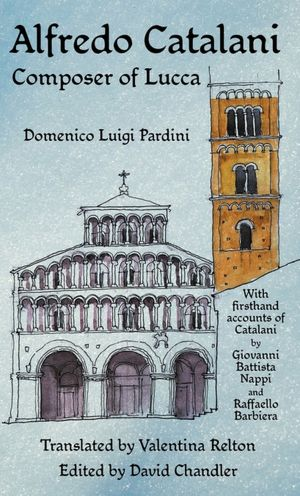April 26, 2012
Manon, Metropolitan Opera
There are other juicy roles in the opera, notably that of her Chevalier des Grieux, but a Manon with a vapid Manon never works (no pun on working girl intended). At the Met, Manon has been a major vehicle for singing actresses with small voices but great cachet: Bori, Sayão, Albanese, de los Angeles, and across the Plaza it was a triumph for the vocal acting of Beverly Sills, my first Manon. More recently I have heard Renée Fleming’s listless interpretation at the Met and Natalie Dessay’s rather more on-target version (opposite Jonas Kaufman) in Chicago.
Anna Netrebko has appeared in two DVDs of the opera in rather different styles as she adjusted to different directors’ visions. Now she has come to the Met in a production by Laurent Pelly that allows her to be Manon as she understands this very young, very material girl. A fine actress as well as a talented and hardworking singer with a lovely if not always ideally exploited voice, she makes a thrilling, fully realized sensation in the part.
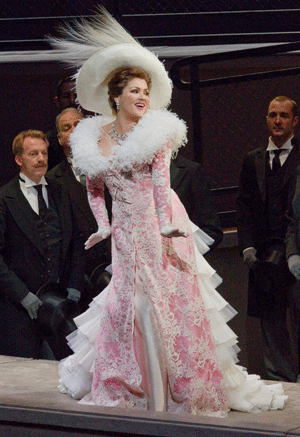 Anna Netrebko as Manon Lescaut
Anna Netrebko as Manon Lescaut
Netrebko brings rather more voice to Manon than is usually the case. She restrains her full-throated sound in the opening scenes, when Manon is fifteen and—at least in Act I—a virgin, albeit une jeune fille en fleur. She then exploits the voluptuous grandeur of her sound to the full to play the haughty beauty of the Cour-la-Reine and the passionate seductress of St. Sulpice. She reaches an ecstatic pinnacle in the Hotel de Transylvania scene, and her glow of sensual delight in the thrill of life and high society and being an object desired by Des Grieux and every other man in the room (and envied by all the women whom she used to envy) flushed body and voice with narcissistic delight. The pitiful comedown (enhanced by Chantal Thomas’s despairing, empty landscape—the best setting of the production) was perhaps not so sickly, so evanescent as the usual Manon plays it. Netrebko still had plenty of lung power to display, expressive more of agony than resigned regret. This makes me eager to hear her take on Puccini’s Manon Lescaut, which requires full-blooded sensuality in the voice from start to finish and hasn’t had it since Freni and Scotto stopped singing the part.
In any case, I can guarantee that those who go to the opera for Netrebko in Manon will not find a half-understood, half-realized or lackluster portrayal. She is bursting with life even in her saddest moments, which makes the fluster she creates among the men around her perfectly comprehensible—even in the Pelly production that (in keeping with our pornographic age) insists on making explicit, shoving our nose into, what Massenet is content to imply: the rape fantasies not merely imagined but enacted by just about every male on stage, of Manon and of every girl in the corps de ballet. (I think Massenet had it right, and Pelly’s direction undercuts the effect of Manon’s fate.)
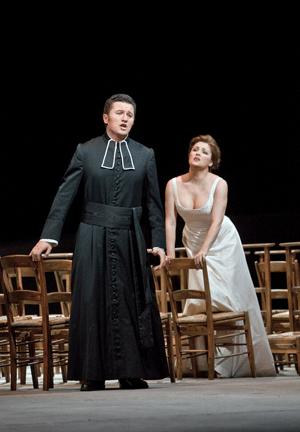 Piotr Beczala as des Grieux and Anna Netrebko as Manon Lescaut
Piotr Beczala as des Grieux and Anna Netrebko as Manon Lescaut
Piotr Beczala plays Des Grieux. He is goodlooking, tender, frenzied by turns, a fine actor and a sympathetic figure. His voice always gives pleasure, interpreting and expressing; if it sometimes fades to indistinction in the distant reaches of the house. Michael Todd Simpson replaced Paulo Szot as Manon’s corrupt cousin at the last minute, presumably with little preparation—but there was nothing in his professional, casually sensuous performance to indicate that anything (in life or this story) was new to him; he was entirely at ease, his voice agreeable and suave, his acting witty and to the point. I am told he is an admired Don Giovanni and I am eager to hear him take it on. Christophe Mortagne, light of step and livid with, alas, not quite impotent indignation, was quite fine as the roué Guillot. The trio of cocottes was played by Anne-Carolyn Bird, Jennifer Black and Ginger Costa-Jackson, top-notch casting for these small but far from insignificant character roles. They set Manon off, inspiring her to her life of ill-fame, but since they have no hearts, they have survived the catastrophe to which she succumbs.
The production is set in fin-de-siècle Paris, an era in which girls of ill fame (and accusation) were not sent to exile in Louisiana. I am not sure what Mr. Pelly thinks he has gained by abandoning the proper era except anything-as-long-as-it-hasn’t-been-done is the current style. Nor is there any point at all in having Des Grieux sleep in a bed in the nave of St. Sulpice except (as we guessed from the rise of the curtain on the scene) it will enable the act to end not with Manon and her priest taking hands and running off but with them wallowing on the blankets. Is this realistic? Do you, if you seduce someone, not seek privacy to consummate the event? Again: It is merely Pelly slavishly following current fashion, which is as evanescent as adolescent passion. I can’t wait to be free of it and of the artists who succumb to it.
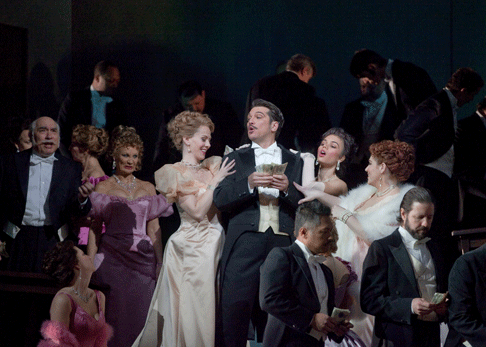 Anne-Carolyn Bird as Poussette, Paulo Szot as Lescaut, Ginger Costa-Jackson as Rosette, and Jennifer Black as Javotte
Anne-Carolyn Bird as Poussette, Paulo Szot as Lescaut, Ginger Costa-Jackson as Rosette, and Jennifer Black as Javotte
Fabio Luisi led the Met orchestra in a suave, elegant account of this long, tuneful score and made the dramatic points: Real emotions lurked under the frivolous surface.
Someone should really tell the Met Titlestm that “abbé” does not mean abbot or imply the existence of an abbey; it is simply a polite way to address a priest in French.
John Yohalem
image=http://www.operatoday.com/Manon_Met_2012_02.gif image_description=Anna Netrebko as Manon Lescaut [Photo by Ken Howard/Metropolitan Opera] product=yes product_title=Jules Massenet: Manon product_by=Manon Lescaut: Anna Netrebko; Des Grieux: Piotr Beczala; Lescaut: Michael Todd Simpson; Pousette: Anne-Carolyn Bird; Javotte: Jennifer Black; Rosette: Ginger Costa-Jackson; Guillot de Morfontaine: Christophe Mortagne; De Brétigny: Bradley Garvin; Count des Grieux: David Pittsinger. Chorus and orchestra of the Metropolitan Opera conducted by Fabio Luisi. Performance of April 17. product_id=Above: Anna Netrebko as Manon LescautPhotos by Ken Howard/Metropolitan Opera
Zagreb’s Wagner Casts Its Spell
They have accomplished this first and foremost by assembling a cast of superlative singers, with pride of place going to the intriguing Kundry as impersonated by Dubravka Šeparović Mušović. She is an artist of great imagination and infinite variety. In Act One, she is a displaced street person, in Two a glamorous seductress who seems on the verge of a nervous breakdown as she vacillates between being Klingsor’s willing accomplice and a penitent in search of redemption. Free-wheeling moments of unbridled lust give way to nervous, guilty tics and stomach-churning disgust (for the character, not us). This was a valid, fully engaged, undeniably schizophrenic take on the character and Ms. Mušović wholly owned it.
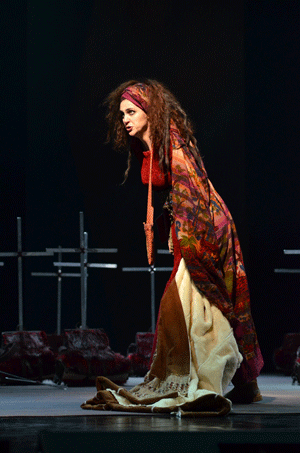 Dubravka Šeparović Mušović as Kundry
Dubravka Šeparović Mušović as Kundry
Nor did she stint in the vocal arena as she let loose with an awesome arsenal of well-calculated effects including a smoldering low voice, searing top, well knit registers, tenderly caressed phrasings, and superbly controlled dynamics, remarkably all of a piece. There was not a moment that she was not invested in the emotional truth of Kundry’s musical lines as she fully immersed herself in a highly personal traversal of one of opera’s most complex characters.
Anton Keremidchiev served up a commanding Klinsgor possessed of what was easily the most beautiful voice I have ever heard cast in this part. Instead of the usual muscled up ranting and bluster, here was a clean, penetrating instrument deployed with a commendable sense of line and dramatic purpose. No parking, no barking, just forcefully beautiful vocalizing.
Veteran Claudius Muth showed off an orotund bass as Gurnemanz, utilized with a keen understanding of his well-schooled technique. The low and middle range rolled out with an easy presence, and while the very highest notes are just outside his core comfort zone, Mr. Muth managed them with consummate skill. Davor Radić contributed a ringing, secure account of Amfortas. Perhaps a tad too secure since his solid, pointed baritone rarely dipped in volume much below forte. A bit of modulation and color would enhance his somewhat stentorian presentation of the suffering soul.
Ivica Trubić likewise intoned a solid, off-stage Titurel, although it was a bit hard to judge any nuance in his vocals since they were amplified with a good deal of reverb. The excellent Flower Maidens were the best matched, most vibrant, and thrillingly sung of any in my experience.
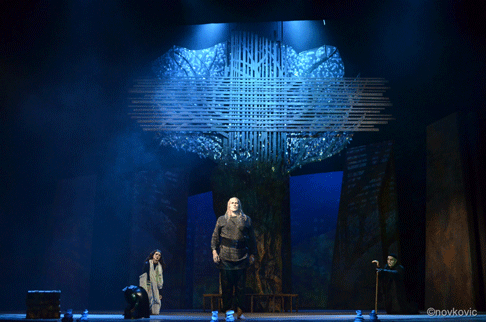 John Charles Pierce as Parsifal, Dubravka Šeparović Mušović as Kundry and Manfred Hemm as Gurnemanz
John Charles Pierce as Parsifal, Dubravka Šeparović Mušović as Kundry and Manfred Hemm as Gurnemanz
That leaves our hero, and John Charles Pierce did not disappoint in the title role. I admit it, I am spoiled. My first Parsifal ever was Jon Vickers, who probably wrecked me for others forever. Mr. Pierce brought complete understanding to bear, and has a pleasant stage manner and a far more than serviceable tenor. Although he seems to cover the sound a bit, when he goes to nail a high phrase, he is able to summon a laser-like clarity. He was never less than thoroughly competent, and often brought joy, but he never quite elevated the role enough to make me forget that his is arguably the least interesting role in the opera.
Conductor Saša Britvić worked musical wonders in the pit helming this musical monster-piece. Predictably, the orchestra fared at its most virtuosic best in the more fiery Act Two, which bubbles and churns along more vividly. In the cruelly demanding expanses of One and Three, the group strove to much good effect in knitting the long, drawn out amblings into a unified whole. There were a few lapses of rhythmic impulse as the piece languidly unfolds (especially in the long rests which sapped the forward motion) and there was a slight dip in accurate intonation ‘round about the 100th minute of Act One, but overall, Maestro Britvić and his players should be duly proud of their achievement. The chorus, too, was trained to a fare-thee-well, and frequently raised goose bumps with their dynamic, poised singing.
To say the production recalls the best of the 1950’s is not to denigrate it in any way. In a nod to Wieland, designer Rudolf Rischer’s basic concept is a circle of Stonehenge-like monoliths that not only revolve at times to interesting new configurations, but also accept all manner of meaningful lighting gobo projections, such as stars, waves, etc. Within this milieu, the addition of a huge, tilted white cross, or the addition of a bridge skirted by red drapes provide all that is needed to adequately communicate Wagner’s intentions.
Gera Graf’s well-considered costumes are also rather timeless, offering a decidedly contemporary twist on the period. Flower maidens burst through the slit red drapes first demurely clad in white nun garb, with the wimples but minus the veils, then change and reappear in glittery, sequined, flesh-colored gowns. The knights are in generic tunics and cowls emblazoned with crosses, each with a sort of red-velvet back-pack that has a metal cross stuck upright in it. These get removed and positioned inventively about the stage, and the crosses later get extracted, upended, and brandished as swords.
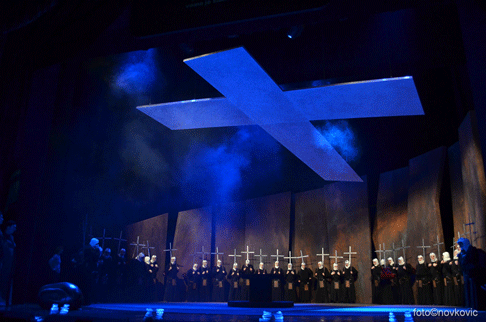 Scene from Parsifal
Scene from Parsifal
Parsifal is all ‘Heroic Montsalvat Man-in-Black’ and sports a wondrous wig of dreadlocks. Indeed all of the hair treatment was quite inspired, and the make-up plot was of the kind you never see anymore, meant to convey features all the way to the top row of the balcony. Kundry’s genial hippie bag lady attire of One yielded to the second act's generic black gown as she was first unfurled, moaning and blindfolded, out of a cocoon of a red carpet. Soon enough, she was got up in a form-fitting black number with an extravagant blond wig, the whole effect topped with a massive “dust cover” of white chiffon. This piece of cloth gets put to creative dramatic use and gets re-purposed any number of times, not least of which as an ersatz spider web.
Roger Vanoni’s lighting design was effectively varied and gloriously colorful. Best of all, the singers faces were (almost) always fully lit. How cool is that? (Or ‘hot’?) A single caveat is that one of the follow-spot operators needs a brush-up in technique. Either Parsifal was being too spontaneous in his Act Two peregrinations or the operator was inattentive or both, for the light was too often playing catch-up to the actor. The concept that Klingsor was clad in a red suit (a la the Devil in Jerry Springer — The Opera) and operated Vari-lights from a sort of DJ desk on the suspended bridge was a fun conceit. When 'Special K' commanded a disco display of flashing lights, it somehow made sense and underscored his control freak persona.
Director Kurt Josef Schildknecht has invested good intentions in his stage pictures and has created plausible relationships between his characters. There is sometimes a tendency to sing forward for implausibly long stretches, but then the plus side is that the balance between stage and pit was excellent. The seduction in Two was played out on a raised circle (Wieland again!) that was at once bed and altar. I quite liked the many ways the actors found to meaningfully place themselves on it, around it, away from it, and under it, all the while communicating volumes with their relative stage positions.
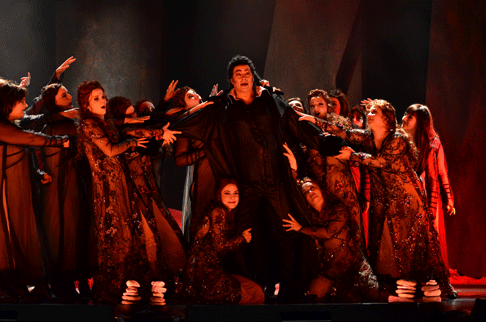 John Charles Pierce as Parsifal with Blumenmädchen
John Charles Pierce as Parsifal with Blumenmädchen
Did everything work? Well, no. Klingsor’s hurling of the spear was ineffectual with two extras simply carrying it aloft to Parsifal who has absolutely no challenge to feebly raise his hand and grab it. However, I did like that he then used it and his sword to create a “cross,” the sight of which brought Klingsor to his knees like Dracula in submissive revulsion. The contemporary hospital bed for Amfortas remained a distraction for me throughout. And his hobbling around with crutches was dishonest since the actor could not remotely suggest that the character could not walk unassisted. Too, there was one unintentionally humorous moment, when a “page” was required to strike a three foot tall stack of ‘heavy’ over-sized books by just lifting them up and off like the Styrofoam they were!
Still, there are so many riches that were so successfully mined here from the challenging, enigmatic masterpiece that is Parsifal, that Croatian National Opera is to be (and was) loudly cheered for having brought such a thoughtful and committed performance to life.
James Sohre
image=http://www.operatoday.com/Parsifal_Zagreb_01.gif image_description=John Charles Pierce as Parsifal and Dubravka Šeparović Mušović as Kundry [Photo by S. Novković courtesy of Hrvatskoga Narodnog Kazališta U Zagrebu] product=yes product_title=Richard Wagner: Parsifal product_by=Amfortas: Davor Radić; Titurel: Ivica Trubić; Gurnemanz: Claudius Muth; Parsifal: John Charles Pierce; Klingsor: Anton Keremidchiev; Kundry: Dubravka Šeparović Mušović; Conductor: Saša Britvić; Director: Kurt Josef Schildknecht; Set Design: Rudolf Rischer; Costume Design: Gera Graf; Lighting Design: Roger Vanoni product_id=Above: John Charles Pierce as Parsifal and Dubravka Šeparović Mušović as KundryPhotos by S. Novković courtesy of Hrvatskoga Narodnog Kazališta U Zagrebu
LA Opera Names New CEO
By Frank Cadenhead [Opera Today, 26 April 2012]
Christopher Koelsch has been tapped Wednesday as the new president and chief executive officer of the Los Angeles Opera. Koelsch, 41, was the opera’s chief financial officer and will take the new post September 15.
Christopher Koelsch Tapped by LA Opera
According to the Los Angeles Times, “he will report to tenor Plácido Domingo, who serves as L.A. Opera’s general director.” Mr. Domingo, an international star, spends only a small percentage of his time in Los Angeles and his term is set to expire next year.
“For the first time in five years, Los Angeles Opera will have one person overseeing both the company’s artistic efforts and finances on a daily basis.” continues the Los Angeles Times, while clearly suggesting that only Domingo has decision-making authority. Mr. Koelsch, who has held positions with the Spoleto Festival in South Carolina and, briefly, Opera Pacific, has little experience directing an opera company.
Koelsch replaces Stephen Rountree who was dividing his time between co-directing the Opera with Mr. Domingo and heading up the Los Angeles Music Center complex. He indicated that he will combine the desks of CEO and COO so his former position will not be filled.
The Los Angeles Opera received an emergency grant from the county in 2009 in order to avoid closing. Since that time, economies have been made and half the loan has been repaid. Now presenting only six operas per year, Koelsch suggested that for the season after next, there might be seven on the Los Angeles Opera schedule.
Frank Cadenhead
image=http://www.operatoday.com/Christopher_Koelsch.gif image_description=Christopher Koelsch product=yes product_title=Christopher Koelsch Tapped by LA Opera product_by=By Frank Cadenhead product_id=Above Christopher KoelschManon Lescaut, Philadelphia
The latter is a tribute to the company management, which programmed a work not heard in Philadelphia for decades in lieu of yet another Bohème, Tosca or Butterfly, and then overcame adversity to craft an enjoyable evening.
Opera Philadelphia often benefits from the remarkable number of fine singers trained in local conservatories—but rarely as much as in this production. When the scheduled soprano (Ermonela Jaho) cancelled less than a month ago, Texas-born Michelle Johnston, a 29-year old in her final year at AVA, stepped in, learned the role from scratch, and sang it with distinction. A grand finalist in last year’s Met national auditions, Johnston is a well-schooled singer with the most of the resources to tackle the singular challenge of Manon, whose evolution from youthful innocence through giddy greed to death in disgrace is mirrored by a vocal transformation from lyric to coloratura to spinto soprano. She was most impressive in slimming down her voice for the Act II minuet scene, complete with a (quasi-) trill. Given her youth and the rushed conditions of her premiere, it is perhaps inevitable that, earlier and later, Johnston sometimes seemed a bit cautious. Later in the run, she will perhaps cut loose more at the big emotional moments, such as the aria, “Sola, Perduta, Abbandonata.” Overall, however, this was a smart and sensitive performance by a young singer to watch.
Thiago Arancam is a 32-year old Brazilian lirico spinto tenor who started singing late and has been trained largely in Milan. He is a sexy guy on stage, with a voice both pleasant and intriguing, mostly due to its unusually dark color—a quality often thought to signal grand heroic potential. For the moment, he sings smoothly and in tune, if uniformly at forte. Yet the sound in the middle and lower parts of the voice lacks the mixture of warm timbre and clear ring Italian tenors prize, and sometimes fades out suddenly—a quality that suggests the tone is being forced. Even at best, the result, some robust high notes aside, his agreeable approach skims over subtleties in the character of the Chevalier des Grieux: his flirtatious serenade, sweet reflection on falling in love, and the gut-wrenching "No! No!, Pazzo son" all sounded vaguely similar. Perhaps Arancam—scheduled to sing this role in Dresden under Christian Thielemann in a year—will yet realize greater potential.
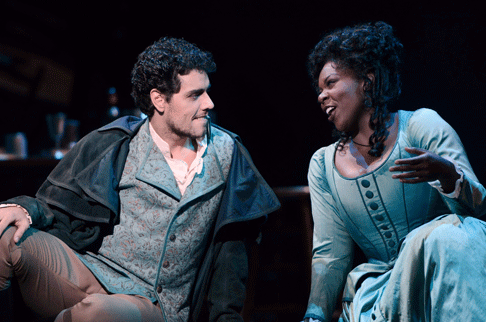 Thiago Arancam as Des Grieux and Michelle Johnson as Manon Lescaut
Thiago Arancam as Des Grieux and Michelle Johnson as Manon Lescaut
Two character baritones supported the cast well. Daniel Mobbs continued his strong work for Philadelphia, seeming to inhabit to the character of Manon’s rich seducer and patron Geronte de Ravoir. Troy Cook was strong if a bit uneven as her brother. Cody Austin sang brightly as the student Edmondo, John Viscardi pranced menacingly as the Dancing Master, and John David Miles’s robust tones came out of nowhere as the Sergeant.
The production was vintage Philadelphia: realistic, colorful, and cost-effective without probing even the (relatively shallow) depths of Manon Lescaut’s libretto-by-committee. Still, it offered one interesting idea, namely a (mechanically-challenged) drop with projected paraphrases from of the literary text from which the story originates.
Music director Corrado Rovaris was largely in his element in this fast-moving score, with the orchestra responding brilliantly—better than I have ever hesrd them—in moments such as the police raid at the end of Act II. To be sure, one might have liked to hear Rovaris encourage the young cast to linger at other critical moments, but rubato is not his thing.
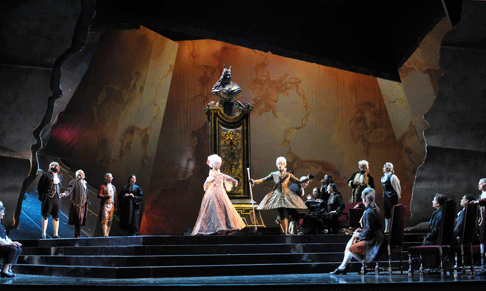 Scene from Manon Lescaut
Scene from Manon Lescaut
Given the success of this production, perhaps Philadelphia will now dare to extend its successful string of operas by 20th-century master Hans Werner Henze to include his unjustly neglected adaptation of the Manon tale, Boulevard Solitude.
Andrew Moravcsik
image=http://www.operatoday.com/Manon_Lescaut_Phil_01.gif image_description=Michelle Johnson as Manon [Photo by Kelly & Massa Photography courtesy of Opera Company of Philadelphia] product=yes product_title=Giacomo Puccini: Manon Lescaut product_by=Click here for cast and other production information. product_id=Above: Michelle Johnson as ManonPhotos by Kelly & Massa Photography courtesy of Opera Company of Philadelphia
Matthias Goerne, Los Angeles
But then any performance by Goerne is sure to be extraordinary. The German singer has taken every aspect of the performance of lieder far beyond what it was when lieder recordings of an earlier generation of singers; Gerhard Husch, Friedrich Schorr, Lotte Lehman, became available to international audiences. His physical and vocal presentations have offered fresh insights and set new standards for the two generations of lieder aficionados nurtured by the voluminous recordings (at least twelve of Winterreise alone) and world-wide performances of Dietrich Fischer-Dieskau. Goerne was in fact, considered Fischer-Dieskau’s anointed heir. Not only had he studied with him, as well as with Elisabeth Schwarzkopf, but Fischer-Dieskau had recommended his young student as a replacement for himself when he retired in 1993. Goerne, however, considers the most important teacher in his life to have been Hans-Joachim Beyer, an assistant at the Mendelssohn Hochschule in Communist East Germany (he is cited on the singer’s web page) with whom he studied for two years. For an hour and a half a day, according to Goerne, ‘‘we only did exercises, no singing. Lots of la-la-la-la, ne-ne-ne-ne.’’
I first heard Goerne sing Winterreise at his Carnegie Hall debut in 1999 and was mesmerized by the intensity of his singing, a kind of innigkeit that few singers could achieve. He had burst on to the international musical scene several years earlier, much heralded for his youth, and for the warmth of a dark voice capable of floating the most tender pianissimo phrases. He was thirty-two in 1999, and accompanied by sixty-eight year old Alfred Brendel, long associated with Fischer-Dieskau and now drawn back to the world of lieder by Goerne’s voice and talent. Goerne was clearly nervous. He was dressed unconventionally, repeatedly moved his body, touched his hand to his nose obsessively, and his early pianissimi were not always audible. Yet he seemed in a world of his own into which his flexible voice drew a willing audience. Clearly, since then he has made journeys of his own. Though his appearance and his (what to some seem excessive) movements remain essentially unchanged, his voice has filled out and darkened, as has his view of both Winterreise and Die schöne Müllerin. In the intervening years he has performed and recorded an extensive German repertoire with many pianists, but in Christian Eschenbach, with whom he is currently recording Schubert songs for Harmonia Mundi, he seems to have found a musician intimately attuned to his own view of these works.
Both song cycles are based on poems by Wilhelm Müller, almost exactly Schubert’s contemporary. Both tell the story of young men, who having loved and lost, are driven to darkest despair, and both reflect the highly romantic age in which they were created. Romantic, not only because they speak of love - but of unattainable, unrequited love (opera lovers, think Werther) - and because the romantic era was characterized by a new awareness and intimacy with nature. In Müller’s poetry every reference to a tree, a flower, a cloud, a drop of water, every adjective describing a tree, a flower, a dog, a bird, assumes a far deeper meaning. When Schubert added his lyrical gifts and musical onomatopoeia to this fevered mix, he created a medium in which every syllable of every sung word – every note on the piano, is not merely itself, but may foretell, recall, reflect on any shade of human destiny. Die schöne Müllerin consists of twenty songs, Winterreise of twenty-four, sung without interruption. To construct the cycle, each song, with its own story, its own mood, in its own key and rhythm, must fit in its place as neatly and properly as a stone in an arch. The highly compressed world of lieder is an art form that sorely tests singers and their pianists.
Though Die schöne Müllerin is a tale of lost love, it begins brightly with the sound of the rushing brook and turning of the wheels that propel the mill. (Ah, Schubert’s exquisite ability to portray sunshine on streams) Generations of singers have performed the cycle in a way that is sympathetic to the doomed youth. Early on Goerne viewed the protagonist as an emotionally disturbed man. His depiction of the rejected youth has darkened to the point where he considers him as madly self-centered, paranoid to the point of blaming everyone else for his troubles. “Mein”, generally treated as a joyous discovery of love, begins with the voice of the murmuring brook in the piano. Entering the scene, the boy tells the brook to stop its murmuring so that he can fill the world with his discovery that the müllerin loves him. However, Christian Eschenbach’s brook didn’t murmur, it thundered. And Matthias Goerne didn’t entreat it to silence, he commanded it. And for the repeated words “mein, mein, mein”, usually heard as a bright joyous syllable, Goerne reached into the depth of his voice for a “mein” that sounded almost villainous.
“Des Baches Wiegenlied” (“The Brook’s Lullaby”) the last song of the cycle completes the romantic cycle – the boy who has yearned for love, found it and lost it, now drowns himself in the brook. Goerne and Eschenbach performed this piece at an extremely slow pace. Astonishingly, as overtones hovered almost interminably between phrases and their resolution, neither singer nor pianist lost the melodic and harmonic threads of the piece. At its conclusion, Christian Eschenbach’s hands remained on the keyboard and Matthias Goerne, bent low, with his head almost in the body of the piano, commanded the audience to silence.
Eventually it erupted into applause.
The two artists looked exhausted.
The protagonist of Winterreise has already lost the girl when we meet him. He is traveling he knows not where, through the natural world at its most fearsome; in the winter - with snow, ice, blowing clouds, fierce winds. He is followed by a crow, dogs bark at him, his tears freeze, the brook freezes over. Though the overall mood of the cycle varies little, Schubert makes use of folk tunes throughout Winterreise, and an endless variety of subtleties are depicted in text and music: rhythmic and harmonic patterns describe tear drops, footsteps, hoof beats, rays of light, threatening clouds. There are few recollections in Winterreise. It is about the present. A man is telling us of the aimless day-to- day bleakness of his life. To sing for an hour and a half about despair in all its various shades and shapes, requires the highest degree of that innigkeit and intensity of which Goerne is a master. He and Eschenbach seemed as one in the coloring, pacing, and tempi of Winterreise. This was the angriest Winterreise I ever heard, yet it was sung as though fury was the only reaction available to the lost soul on the stage. “You have a voice that speaks to people....a way of focusing a listener’s attention,” Fischer-Dieskau is said to have told him.
“Der Leierman”, (“The Organ Grinder”), the touching concluding song is enigmatic. It depicts an impoverished old man, ignored by people, pursued by dogs, wandering barefoot through snow, constantly playing his tunes in the hope of a few cents. Does our unhappy young man follow him? And of so, into what? The constancy of hope and life? Or to certain death? We cannot know. We are left to make our own conclusion.
For the effect that Matthias Goerne’s voice has on the listener, I hope that readers of this review, particularly those not acquainted with German lieder, repeat a little experiment I just tried. Search “Der Leiermann” on “You tube” and listen to Dietrich Fischer-Dieskau, Ian Bostridge, Peter Schreier, the superb Thomas Quasthoff, and any other great voice that you can find, then listen to Matthias Goerne. Beyond the question of interpretation, I think you will find a certain (without intending to be off-hand about it, I have to say) je ne sais pas in his voice. A depth? A gravelly quality? A slight vibrato? Whatever it is, I think it will find an echo in your own heart.
And what about Herr Goerne’s own journey as a singer? “Time and patience are the most important things,’’ he has said. ‘‘In every phase, whether you’re 21 or 31, you need to feel that this moment is the ne plus ultra. You can’t tell yourself that in five years you’ll do a piece differently or better. But five years later, you look back and you can see that you’re in a new place. It’s a sign that you’ve been working hard.’’
Estelle Gilson
image=http://www.operatoday.com/GOERNE_Borggreve006.gif image_description=Matthias Goerne [Photo by Marco Borggreve for harmonia mundi] product=yes product_title=Sublime Schubert product_by=Matthias Goerne, baritone; Christian Eschenbach, piano. Walt Disney Concert Hall. Franz Schubert: Die schöne Müllerin April 16, 2012. Franz Schubert: Winterreise April 18, 2012. product_id=Above: Matthias Goerne [Photo by Marco Borggreve for harmonia mundi]Der Freischütz, London
Premiered at the Berlin Schauspielhaus in 1821, by the end of the decade it had already received productions in Danish, Swedish, Czech, Russian, English, French, Hungarian, Polish and Dutch, and by 1850, stagings had been mounted as far afield as Cape Town, Rio de Janeiro, and Sydney. Of course, it is in many ways the quintessential German Romantic opera, though one should always remember how much influence other ‘national’ traditions wield over it, but it is saddening that we, or at least the powers that be, should apparently evince so little interest in this tradition. Oberon was programmed to appear this season at Covent Garden, a mouthwatering prospect, only to be cancelled in favour of yet another run — within the same season! — for La traviata. The only staging of Der Freischütz I have seen in London, or indeed elsewhere, was that by ENO in 1999. Meanwhile, Calixto Bieito has just presented a new production in Berlin for the Komische Oper, a must-see staging by all accounts. Perhaps ENO, with its reinvigorated interest in co-productions will bring it across the Channel at some point; we can but hope. Many thanks, in any case, are due to the LSO for this concert performance.
It is not, of course, a work without its problems, first and foremost of which is surely Johann Friedrich Kind’s libretto (even if that seems a masterpiece when compared with the ludicrous effort from James Robinson Planché for Oberon). The dialogue, especially in a concert performance, can present difficulties for a non-German cast, so it is understandable that a decision was made to ditch it in favour of an English narration by Amanda Holden. Whether the latter in any sense marked an improvement remained unclear, to say the least. Malcolm Sinclair’s delivery, whilst clear, was definitely on the ac-tor-ly side, the narration itself prosaic and yet lodged precariously between sanitised fairy-tale — fairy-tales should be anything but sanitised! — and camp. Of the work’s darkness there was little or nothing to be heard. In 1841, sickened and impoverished by the superficiality of Parisian musical culture, the homesick Wagner wrote of a performance: ‘It seems to be the poem of those Bohemian woods themselves, whose dark and solemn aspect permits us at once to grasp how the isolated man would believe himself, if not prey to a dæmonic power of Nature, then at least in eternal submission thereto.’ For a sense of that crucial quality, one had to turn to the music — and indeed, perhaps one always did.
Sir Colin Davis has a lengthy history with the work; he recorded it with the Staatskapelle Dresden — Weber’s own orchestra, of course, and Wagner’s too — twenty years ago, and these two performances have been recorded for release on LSO Live. This was not a reading of incendiary drama such as one hears on Carlos Kleiber’s legendary recording, also with the Dresden orchestra, but won over as one can hardly fail to be by that performance, it is easy to forget how unorthodox it is. Take, for instance, the waltz in the first act, preceding Max’s recitative and aria. Kleiber’s tempo is, on the face of it, bizarrely fast, though somehow it works. Furtwängler takes it far more slowly, as did Davis, though his reading sounded closer to the sound and at times implacability one might have expected from a Klemperer Freischütz. (Now there is a thought; he certainly conducted it in his youth; indeed he made his debut at the Prague Deutsches Landestheater with it, in 1907.) These were sturdier peasants; I can imagine some finding the results staid by comparison, but there was actually a subtler vigour at work.
The Overture was another case in point, its opening gravely Beethovenian. Despite the difference in tempo and almost everything else, I was somehow put in mind of Coriolan. An unfortunate split horn note was heard upon the horns entry, but thereafter, throughout the work, the LSO’s horns were on excellent form, just as required in this of all operas. There was a sense of fairy-tale: I thought of Davis’s Hänsel und Gretel for the Royal Opera. But there was also, and increasingly so, Wagnerian gravity to be heard, reminding us that, so many times in this work, Siegfried is but a stone’s throw away. Fafner’s lair takes form in the Wolf’s Glen Scene. And there was no shortage of dramatic drive to the conclusion of the Overture, but Davis and his wonderful orchestra saw no reason to resort to anything hinting at superficial display. Orchestral malevolence was to be heard in spades at the opening of Kaspar’s aria, ‘Schweig! damit dich niemand warnt,’ and a proper storm was cooked up in that celebrated finale to the second act. (Electronic sound effects proved slightly alienating, but what does one do in a concert performance?) If not exactly folksy — and does one really want that? — there was certainly a nice orchestral jauntiness to Ännchen’s ‘Kommt ein schlanker Bursch gegangen’. Whilst a list of notable orchestral solos would doubtless extend to almost every section principal, I feel I cannot fail to mention the superlative contributions of leader, Carmine Lauri, Rebecca Gilliver (cello), Gareth Davies (flute), and of course, the viola obbligato in ‘Einst träumte meiner sel’gen Base’ (it looked like Paul Silverthorne to me, although the programme said otherwise, so I should probably credit Edward Vanderspare too, just in case).
The London Symphony Chorus was on predictably fine form too. Its choral weight and attack registering unfailingly from the opening Huntsman’s Chorus onwards. Both the chorus and Davis were keenly aware of the echoes of Haydn’s Die Jahreszeiten — they recorded it relatively recently — a little later on during the first act. Would that one could hear more choral singing of such distinction in the opera house! Simon O’Neill performed a decent, professional task. He can sing the notes — and did. He can sing the words too, but there remains, as I have generally found with this artist, a lurking suspicion that he is not always entirely clear what the words mean. Moreover, the pinched quality of his voice is, despite its heft, becoming increasingly pronounced. It is perhaps easier to take here than in a work on the scale of Die Meistersinger, but one could hardly call it ingratiating. Christine Brewer again certainly has the required vocal heft for the work. Her wobble became unduly pronounced in her second act aria, but sincerity of spirit won through here, and in a lovely third-act cavatina. To start with, I found Sally Matthews’s timbre a little pallid, but was soon won over. There was certainly much to esteem in her clarity of line (not least vis-à-vis certain of her colleagues), and she handled the coloratura not only with ease but with a sure understanding of its dramatic purpose. A distinguished performance indeed! Lars Woldt was a late replacement for Falk Struckmann as Kaspar. He shone in the role, not least on account of his natural ease with his native tongue. I can imagine some might have found his vibrato a little heavy — I did not — but there was, vibrato aside, something impressively resounding to his tonal quality and delivery. The appearance of Stephan Loges as Ottokar — it is pretty much impossible to judge his electronic appearance as Zamiel — made one wish, from its elegance of delivery, that the character had more to sing. Gidon Saks wobbled a bit as the Hermit, but I am not sure that matters too much with respect to that particular role. I should also definitely mention a winning, stylish Killian from Marcus Farnsworth; again, it was difficult not to wish that the role might be expanded. Martin Snell and Lucy Hall rounded off with aplomb a cast of many virtues.
If it is difficult, then, quite to see those Bohemian Woods in the concrete jungle of the Barbican Centre, and the nature of the concert performance made for a less Romantic rendering than one would hope for in the theatre, this performance exhibited many singular qualities. It will certainly be worth hearing on CD.
Mark Berry
image=http://www.operatoday.com/Carl_Maria_Von_Weber.gif image_description=Carl Maria von Weber product=yes product_title=Carl Maria von Weber, Der Freischütz, J.277 (concert performance) product_by=Ottokar, Zamiel: Stephan Loges; Kuno: Martin Snell; Agathe: Christine Brewer; Ännchen: Sally Matthews; Kaspar: Lars Woldt; Max: Simon O’Neil; Hermit: Gidon Saks; Killian: Marcus Farnsworth; Four Bridesmaids: Lucy Hall; Narrator: Malcom Sinclair; London Symphony Chorus ; London Symphony Orchestra/Sir Colin Davis (conductor). Barbican Hall, Saturday 21 April 2012. product_id=Above: Carl Maria von WeberApril 25, 2012
Richard Strauss: Salome
In contrast to stagings of Salome which present the work in costumes and sets that evoke images of first-century Judea, the stage design by Hans-Martin Scholder, with costumes by Bettina Walter, is a modern-dress production. Even without robes, sandals, and other accoutrements of costume drama, the presentation is effective in giving the work a timeless quality, which works well conceptually. The modern setting does not get in the way of narrative, and the intensity that stage director Nikolaus Lehnhoff brings to the work complementing the expressiveness Stefan Soltesz brings to the performance.
Angela Denoke is convincing in her portrayal of the title character. Her approach to Salome gives a sense of youthfulness that shifts as her fascination with Jochanaan takes on tragic dimensions. The intensity of Denoke’s performance is matched by her facile approach to the role, which is well within her technical and expressive abilities. The physicality of the role goes beyond executing the famous “Dance of Seven Veils,” since an effective performance should reflect the fascination Herod has for his step daughter. Denoke conveys this, as Kim Begley’s Herod seems both drawn to Salome and bound to his wife Herodias. As Herodias, Doris Soffel is believable as Herod’s wife and demonstrates well the bonds that allow her to manipulate Salome in requesting the head of Jochanaan, John the Baptist, as the price for his foolish oath. In the role of the prophet Jochanaan, Alan Held has a solid vocal and physical presence. The stylized Mohawk hair style given to Jochanaan sets him apart from the conventional styles given to the members of the court, with the attention given to the head subtly emphasizing that part of the body, since his head is key to the climactic moment when Salome lustily kisses the detached skull as she indulges her lips with those of Jochanaan.
In allowing her character to shift from being fascinated with Jochanaan to being obsessed with him, Denoke underscores the intensity not only in her acting, but her approach to the music. Without allowing the part to evince any strain, Denoke makes a powerful musical transformation from the beginning of the work to its tragic conclusion. The dramatic sound of her voice in the final scene is convincing, as the character of Salome conveys a sense of ruthlessness that repels Herod, as much as the coquetry depicted earlier in the opera had attracted him. This shift in perspective is important in successful performances, like this one.
In the role of Herodias, Doris Soffel is appropriate both vocally and dramatically. Her demeanor gives a sense of the wounded pride that motivates the queen to manipulate her impressionable daughter. While this is implicit in the libretto, this dimension is part of the presentation recorded her. Soffel is exemplary in this role, as is Kim Begley, who creates an equally intensive characterization of Herod. Without employing the histrionics that some introduce into performances of Herod, Begley allows the music to emerge easily in characterizing the flawed and erring king. This is a passionate, full-voiced Herod, performed with the artistry this opera needs. Along these lines, Alan Held is powerful as Jochanaan, with a commanding presence when he is on stage. His resolute performance fits his character well.
As strong as the performances are, the staging merits attention for the way it allows the drama to unfold. The requisite pit where Jochanaan is imprisoned is part of the design in its placement under the center of the stage. The surrounding walls give a sense of the palace confining the nobility, almost like the prison implied below for the Baptist. This is offset by the raised walkway in the back, which is part of many shots in the DVD as it allows for various entrances to occur facilely. At the same time, the suspended walkway also becomes the means for the guard, who eventually executes Salome, to be present throughout the drama. It underscores his entrance at the climax of the opera, so that this it is neither sudden nor unexpected. In addition, the colors used in the production and reproduced in the DVD are evocative for the ways they suggest shifts in the drama. Salome’s pink dress is prominent in the first part of the drama, and changes to a yellow, almost flesh-tone, shift after the famous “Dance of Seven Veils.”
The sound in this recording is has a welcome presence in supporting the voices without overbalancing them. Yet in orchestral interludes and the extended “Dance of Seven Veils” the orchestra is appropriately prominent, with the engineering supporting the fine performance at the core of the production. It allows the finesse of Stefan Soltesz to be heard well in this exemplary DVD. This staging of Salome merits attention, as does the excellent performance of the title role by Angela Denoke.
Jim Zychowicz
image=http://www.operatoday.com/ArtHaus_Salome.gif
image_description=ArtHaus Musik 101593
product=yes
product_title=Richard Strauss: Salome
product_by=Salome: Angela Denoke; Herodes: Kim Begley; Herodias: Doris Soffel; Jochanaan: Alan Held; Narraboth: Marcel Reijans. Berlin Deutsches Symphony Orchestra. Stefan Soltesz, conductor. Nikolaus Lehnhoff, stage director. Hans-Martin Scholder, stage designer. Bettina Walter, costume designer. Duane Schuler, lighting designer. Denni Sayers, choreographer. Recorded live from the Festspielhaus Baden-Baden, 2011.
product_id=ArtHaus Musik 101593 [DVD] | 108037 [Blu-Ray]
price=$37.99 (Blu-Ray)
product_url=http://www.arkivmusic.com/classical/album.jsp?album_id=687741
Angel Denoke, Kim Begley, Doris Soffel, Alan Held, Marcel Reijans, Deutsches Symphonie-Orchester Berlin, Stefan Soltesz, conductor. Arthaus Musik DVD 101 593 (also released as Blu-Ray disc 108037)
La Fille du Regiment, Royal Opera
Having conquered operatic stages in Europe and the US during the past five years, Laurent Pelly’s Tyrolean troopers/troupers have tramped back to London, with a sway and a swagger; the company’s stalwarts demonstrate their stamina while some of the leaders take a breather and make way for new recruits.
In particular, Natalie Dessay has resigned from the brigade. In 2010, on the occasion of the first ROH revival, I remarked that the role “is fast becoming a signature role — and indeed it is hard to imagine this production without Dessay”. However, Patrizia Ciofi more than proved me wrong: lacking Dessay’s manic agitation — a gamine hyperactivity that was often achieved at the expense of vocal finesse — Ciofi’s Marie is an altogether more rounded, and composed, character: an energetic, at times unreasonable adolescent, yes, but also a burgeoning young woman with hopes and dreams with which we can identify. Ciofi’s diction at times lacks lucidity; and her wide vibrato — especially at the top where it frequently forces the pitch upwards — is unfortunate in more sustained, ensemble passages.
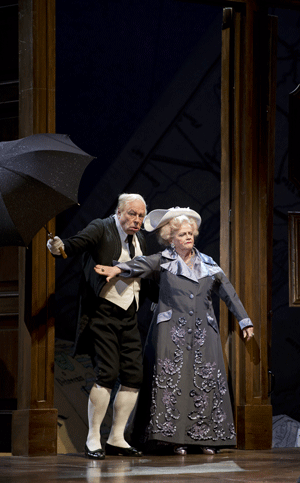 Ann Widdecombe as La Duchesse De Crackentorp and Donald Maxwell as Hortensius
Ann Widdecombe as La Duchesse De Crackentorp and Donald Maxwell as Hortensius
But, Ciofi has the high tessitura and breathtaking coloratura easily under her belt — or should I say braces — and has a rich, creamy tone. Hers is a Marie who makes us laugh and cry. Whether wobbling determinedly across the stage, buried beneath laundry mountains, or leaping aloft a potato bucket to entertain the troops, or being violently hoisted upside down or horizontal as she is ‘abducted’ by her newly found aunt, Ciofi retained her equanimity. Overall, she may lack some of Dessay’s hard-hitting punch but hers is a more genuine bel canto idiom.
Colin Lee has taken progressive but unceasing strides to the front lines: as Juan Diego’s understudy in 2007, he shared the role in 2010 and now stepped into the full glare of the spotlight. Certainly Lee has the vocal gifts and musical temperament to dispatch the infamous high Cs in ‘A mes amis’ — the last relished and sustained to substantial applause. And, in the yodelling leaps he revealed a heroic timbre to counter his previous hapless, bumpkin-esque persona, revealing the sincerity of Tonio’s affections. Although Lee may not possess the physical and vocal appeal of his predecessor in this production, he does have a confident, controlled elegance: his superbly shaped, long, legato lines pay detailed, intelligent attention to phrasing, and the effect is complemented by a focused vibrato, which was put to superb effect in his tender declaration of love, the Act 2 aria, ‘Pour me rapprocher de Marie’.
Returning as the Marquise de Birkenfield, Ann Murray relished the comic potential of her partnership with Donald Maxwell’s emasculated Hortensius. Her Act 1 account of the loss of her sister’s child is in danger of taking on an air of Miss Prism-esque farce — one half expects Lady Bracknell to pop up pompously pronouncing about perambulators and handbags. Indeed, one of the disadvantages of repetition is that wry comedy can become brutish slapstick: more Loony Tunes than Napoleonic rom-com. That said, as in 2010 Murray’s ‘singing lesson’ with Marie and Sulpice produced some of the finest musical and theatrical moments in the performance. And, Alan Opie’s Sulcipe was the warm embodiment of paternal indulgence — even when his feisty ‘daughter’ disowns him and declares her intent to find a regiment of ‘nicer daddies’.
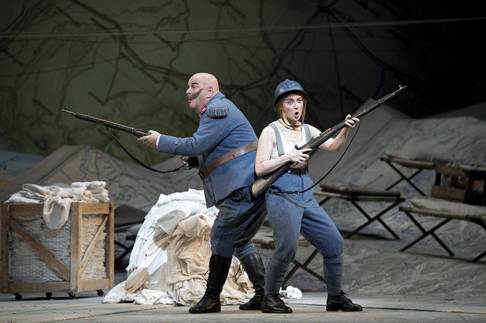 Patrizia Ciofi as Marie and Alan Opie as Sulpice Pingot
Patrizia Ciofi as Marie and Alan Opie as Sulpice Pingot
Stepping into Dawn French’s shoes as the Duchesse de Crackentorp, Ann Widdicome shares little with her predecessor except her girth — or rather, French’s former girth, given that the latter has recently revealed a new svelte figure. Hot from her Strictly and panto successes, Widdicome is clearly riding a popularist wave — rather surprising for one who made her name as a bastion of Tory/Victorian principled intolerance. However, politics aside, those who witnessed Widdicome’s Strictly ‘triumph’ will be aware that rhythm is not one of her fortes; she possesses none of French’s insouciant comic timing or improvisatory invention. Indeed, it even seemed quite a challenge for her to remember her lines. That said, self-referential surtitles — a bellowing ‘Order, Order!’, and many Strictly references — raised hilarity among the audience, so presumably the ROH management consider this casting well done. I probably deserve censure for failing to appreciate Widdicome’s willingness to laugh at herself and her ability to add to the frivolous fun.
Most pleasingly, the chorus are truly regimented, kept on a tight rein vocally and visually, relishing the mixture of musical self-discipline and the threat of dramatic — and military — mishap.
There is a lot of dialogue to get through, and thus the staging and visual appeal plays an important role in sustaining the audience’s attention: Chantal Thomas’s cartographical collage is both witty and engaging, while the distorted perspective of the Marquise’s château in Act 2 emphasises the bizarre nature of the dramatic development. Balletic dusting routines and a coup de théâtre tank for Tonio’s rescue mission help to overcome any potential dramatic longeurs.
Conductor Yves Abel leads the regimental company on a careful but precise campaign. There was much lovely playing from the ROH orchestra: in the introduction the horns were wonderfully warm and touching, complemented by well-shaped, emotive woodwind and string sectional playing. But, Abel’s tempi were, on the whole, rather slow and conservative — not quite right for the wild abandon on stage; and, he seemed to feel the need to signpost every comic moment with a knowing gesture.
Many chuckles derived from Agathe Mélinand’s surtitles. Indeed, the current Eurozone tensions gave an added frisson to the notion of an Italian soprano cast as a French girl, mangling an Italian aria, written by an Italian for a nineteenth-century French audience, performed in franglais-laden production, directed by a Frenchman, and translated for an English audience.
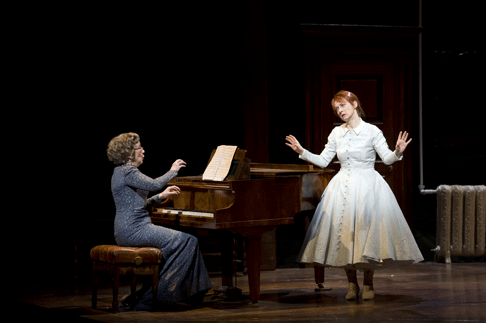 Ann Murray as La Marquise De Berkenfeld and Patrizia Ciofi as Marie
Ann Murray as La Marquise De Berkenfeld and Patrizia Ciofi as Marie
In this context, the contemporary reception of Donizetti’s work is interesting: only two major composers of the age, Mendelssohn and Verdi, genuinely admired him, the former professing, in response to criticism of La fille, “I am afraid I like it. I think it very pretty — it is so merry! Do you know, I should like to have written it myself”. But others, notably Bellini and Berlioz, were less charitable, perhaps in awe and afraid of Donizetti’s prodigious output and adaptability. Indeed, Berlioz accused Donizetti “of treating us like a conquered country; one can no longer speak of the opera houses of Paris, but only of those of M. Donizetti”.
Pelly’s winning production has similarly conquered foreign stages, and there are undoubtedly many deserved victories ahead.
Claire Seymour
image=http://www.operatoday.com/La_Fille_ROH_2012_01.gif image_description=Patrizia Ciofi as Marie and Colin Lee as Tonio [Photo © ROH 2012 / Bill Cooper] product=yes product_title=Donizetti: La Fille du Regiment product_by=Marie: Patrizia Ciofi; Tonio: Colin Lee; Sulpice Pingot: Alan Opie; La Marquise de Berkenfeld: Ann Murray; Hortensius: Donald Maxwell; La Duchesse de Crackentorp: Ann Widdecombe; Corporal: Jonathan Fisher. Conductor: Yves Abel. Director and Costume Design: Laurent Pelly. Revival Director: Christian Rath. Dialogue: Agathe Mélinand. Set Design: Chantal Thomas. Lighting Design: Joël Adam. Choreography: Laura Scozzi. Royal Opera House, Covent Garden, London, Thursday 19th April 2012. product_id=Above: Patrizia Ciofi as Marie and Colin Lee as TonioPhotos © ROH 2012 / Bill Cooper
April 24, 2012
Teatro Real Replaces Miguel Muñiz
By Frank Cadenhead [Opera Today, 24 April 2012]
Ignacio Garcia-Belenguer, 45, has been named as the new general manager of Madrid’s opera, Teatro Real.
Ignacio Garcia-Belenguer Appointed
This change was announced after an April 19 joint meeting of the Advisory Council and the theater’s Board of Directors. Contracted for five years, he replaces Miguel Muñiz who was general manager of the acclaimed house for the past eight years.
Garcia-Belenguer, a Zaragoza native, was appointed administrative manager in February and now will lead the house. Muñiz tendered his resignation last December and will continue on the Advisory Council at the “Royal Theater.” Muñiz is credited with stabilizing the company and creating new audiences. His 2008 invitation to the innovative Gerard Mortier to be artistic director for five years, starting in 2010, guaranteed a higher international visibility.
Spain’s opera houses have been dealing with a substantial reduction in government subsidies and are busy developing private support. Strikes have been threatened in the past weeks at the Teatro Real and have have created difficult times. Threatened with protests is Placido Domingo’s appearance in the Parisian Châtelet production of Alfano’s opera “Cyrano de Bergerac” scheduled for next month. The immediate cause of the threatened work stoppage is a letter to employees of the house demanding a refund of money paid due to an administrative error.
The budget for this season has been reduced by 1.5 million Euros but dramatic economies and projected increased private donations has allowed the Board of Directors to project a balanced budget for the present year.
Frank Cadenhead
Image=http://www.operatoday.com/Garcia-Belenguer.gif image_description=Ignacio Garcia-Belenguer product=yes product_title=Ignacio Garcia-Belenguer Appointed product_by=By Frank Cadenhead product_id=Above: Ignacio Garcia-BelenguerMore Drama in Köln
By Frank Cadenhead [Opera Today, 24 April 2012]
The director of the Cologne Opera, Uwe Eric Laufenberg, has confirmed at the press conference this afternoon that he will leave his post at the end of the coming season. His contract runs until 2016.
Uwe Eric Laufenberg Resigns
Describing the city’s opera as “on its deathbed,” he is leaving due to financial issues with the cash-strapped city. The coming season was planned anticipated a contribution by the city of 54.1 million Euros but only 49 million was thought to be offered.
An increase of 2 million suggested by the city was rejected by Laufenberg as insufficient to guarantee the season. During the press conference, held to announce the new season, he declared that only the first opera of the season has a definitive budget; the rest of the season’s figures were more or less “open.”
The seat of the city’s Cultural Affairs Minister was notably vacant during the press conference. The minister, Georg Quander, had urged further discussions on the financial issues and was angry that this affair was made public.
Frank Cadenhead
image=http://www.operatoday.com/Laufenberg.gif image_description=Uwe Eric Laufenberg product=yes product_title=Uwe Eric Laufenberg Resigns product_by=By Frank Cadenhead product_id=Above: Uwe Eric LaufenbergApril 23, 2012
No Brünnhilde by Angela Denoke
By Frank Cadenhead [Opera Today, 23 April 2012]
Soprano Angela Denoke announced on Wednesday that she would not be appearing as Brünnhilde, one of the critically important roles, at the 2013 Bayreuth Festival Ring Cycle.
Denoke Bows Out of Bayreuth
The newspaper accounts indicated that many Wagnerian fans were unhappy with the choice of Denoke for this monumental four-part epic.
Spokesperson of the Richard Wagner Festival, Peter Emmerich, confirmed the press accounts and commented that “Now someone has to be found who can take over that part. It will not be easy because next year Wagner will be played everywhere.”
The new Ring production will be staged by Frank Castorf and conducted by Kirill Petrenko. 2013 is the 200th Anniversary of the birth of Wagner and the Ring Cycle is expected to be central to the celebration.
Frank Cadenhead
image=http://www.operatoday.com/Denoke.png
image_description=Angela Denoke [Photo courtesy of Askonas Holt]
product=yes
product_title=Denoke Bows Out of Bayreuth
product_by=By Frank Cadenhead
product_id=Above: Angela Denoke [Photo courtesy of Askonas Holt]
April 19, 2012
Show Boat at Lyric Opera of Chicago
Francesca Zambello applied her directorial talents to the current production and allows Show Boat to speak for itself as a straightforward and entertaining piece of theatrical tradition. Featured cast members include Ashley Brown as Magnolia Hawks, Nathan Gunn as Gaylord Ravenal, Alyson Cambridge as Julie, Angela Renée Simpson as Queenie, Morris Robinson as Joe, Ross Lehmann as Captain Hawks, Cindy Gold as Parthy Ann Hawks, and Ericka Mac as Ellie May Chipley. John DeMain conducted the Lyric Opera Orchestra.
After the overture settled from a brassy start into familiar melodic lines, DeMain highlighted rhythmic shifts to good effect. The “Cotton Blossom” song, named for the riverboat with its staged entertainment, was performed with choral energy yet individual phrases could profit from greater emphasis on diction. The argument between the engineer Pete and the actor Steve, which motivates so much of the subsequent conflict, is convincingly staged. Others members of the ship’s community react immediately to Steve’s dismissal and to the isolation of his wife Julie LaVerne. In the role of the undertalented Ellie May, Ms. Mac sings intentionally off-key and overcompensates charmingly in her attempts to portray an ambitious yet ill-trained replacement for Julie in the ship’s roster of actors.
The arrival of Gaylord Ravenal introduces the second dramatic and emotional twist that will have an effect on the remainder of the piece. It is a role that suits Mr. Gunn’s voice and dramatic talents well. In his first song, “Who cares if my Boat Goes Upstream?” Gunn’s sense of line adds to the carefree swagger of Ravenal’s personality. Here and elsewhere the orchestra could serve the soloist better if taken less forte in its enthusiastic accompaniment. The pivotal duet with Magnolia, “Make Believe,” was performed touchingly by Ms. Brown and Mr. Gunn, as the impression of a naïve yet convincing affection was kindled. When left to consider her thoughts, Magnolia asks Joe the husband of Queenie whether this attraction could be a signal of love. As sung by Mr. Robinson, the response of Joe, “Ol’ Man River,” is one of the highlights of the production. Robinson portrays Joe with dramatic physicality and with fully assured vocal technique. His sonorous bass is rich and full in even the lowest pitches, and his legato matches the rolling pull of the river. When Robinson repeats the song subsequently with male chorus, the effect is equally striking. Magnolia’s second confidante Julie hears next of the budding romance. After the trusting exchange with Magnolia, Ms. Cambridge sang the well-known comment on love, “Can’t Help Lovin’ Dat Man.” Cambridge showed here a firm sense of musical line as it supported the text yet the enunciation of lyrics was overly careful. After Ravenal’s gambling song, performed with spirited determination by Gunn, the remainder of Act I alternates between staffing the showboat’s entertainment and the developing romance of the protagonists.
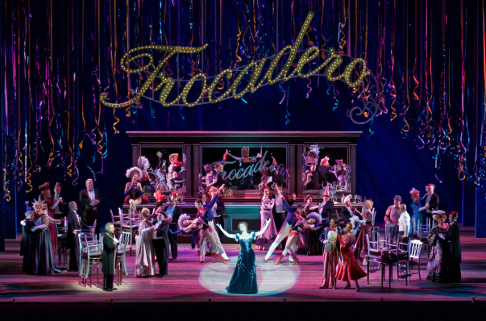
Because of Mississippi racial laws the marriage of Julie and Pete is questioned, a complication leading to her dismissal as lead in the musical show. Captain Hawks decides that his daughter Magnolia will substitute since she is familiar with the numbers from having attended rehearsals. Almost simultaneously Ellie May performs with female chorus the comment, “Life on the Wicked Stage.” Ms. Mac assured that the number was an exhilarating showstopper with all pitches at this point sung correctly. The love between Magnolia and Ravenal blooms, just as they rehearse the fictional parts of lovers on the stage. Brown and Gunn gave a convincing rendition of “You are Love” as they make plans for their own wedding in keeping with the stage-show’s narrative. As Act I ends, stories about Ravenal’s past do not deter Captain Hawks from supporting the marriage yet his wife Parthy’s reaction hints at domestic difficulties in Act II.
In the second act as arranged for this production the chronological sequence unfolded smoothly. The individual scenes cover a span of several decades in the domestic and emotional lives of Magnolia and Ravenal. Only the first scene taking place at the 1893 Columbian Exposition in Chicago gave any indication of the idyllic marriage promised by the lyrical exchange in the first act. The birth of a daughter hardly deters Ravenal from his continued gambling. Indeed one of the most emotionally moving scenes in Act II is Gunn’s departure from his daughter staged in the convent school. The reprise of “Make Believe” in this scene recalls earlier happiness and looks wistfully toward a future reconciliation. For her part Ms. Brown’s portrayal of Magnolia as an independent performer after having been left by Ravenal was achieved with both vocal and dramatic skill. Her voice matured noticeably as she sang “After the Ball,” and sheer confidence could only describe her solo appearance in a Ziegfield show in New York. Since Queenie had attended these latter performances, she repeats one of Nola’s popular numbers back on the show boat. Ms. Simpson sings “Hey Feller!” with gusto and decided glee in her committed enthusiasm. The final reunion of Magnolia, Ravenal, and their daughter takes place, appropriately, where the romance began with the hope of a transformed future.
Salvatore Calomino
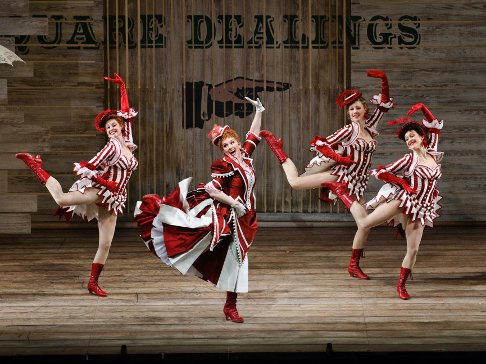
Photos by Robert Kusel courtesy of Lyric Opera of Chicago
Wolfgang Rihm’s Jakob Lenz by ENO
Wolfgang Rihm is one of the most important German composers of our time, and hugely influential. His orchestral and chamber music are well known in Britain, but less so his many operas. Jakob Lenz dates from 1978, when Rihm was only 24, but it’s an established part of the repertoire in Europe.
The Hampstead Theatre is a more claustrophobic performance space than the Young Vic or the Coliseum, which suits this opera well. Jakob Lenz was the Romantic poet who became insane. The stage is shrouded, as if in a mist, surrounded by realistic looking reeds. A reference to Wozzeck working in the reed beds, hallucinating mushrooms. The play on which Rihm’s Jakob Lenz is based was written by Georg Büchner who wrote Woyzeck, the source of Alban Berg’s opera.
Crazy, tangled images of reeds and water permeate this production Jakob Lenz is trapped in his madness: most of the action takes place on a narrow island on a stage within the stage. Lenz (Andrew Shore) keeps falling off the edge into real water, sometimes completely submerged. Pastor Johan Oberlin (Jonathan Best) doesn’t seem to notice, but Lenz’s friend Christoph Kaufmann (Richard Roberts) glances warily round the edges, careful not to lose his footing. It feels dangerous.
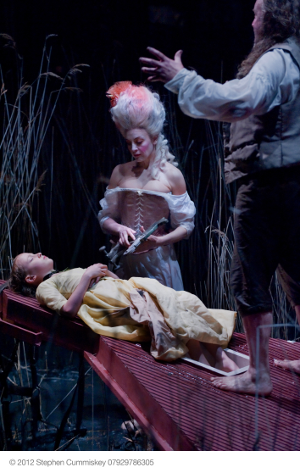 Andrew Shore as Jakob Lenz, Lillie Forrester as one of the children, Suzy Cooper as Friederike Brion
Andrew Shore as Jakob Lenz, Lillie Forrester as one of the children, Suzy Cooper as Friederike Brion
Lenz’s psychosis connects to these waters. He drags a young girl into the pond and drowns her. Or so he thinks. Reason blurs into unreality, just as land blurs into water in these reed beds. Lenz thinks the girl, whatever she may be, is raised from the dead because he prays. “Lenz”, incidentally, means “spring” which would not have been lost on poet, playwright or composer. The girl (Lillie Forrester) isn’t a real girl, but may be Lenz’s idealized projection of himself. “Logical, Logical!” he repeats later, as if mantras will restore order. In that sense, he’s not really so different to the pastor and to the church around which this village clings. An outline of the church looms over the proceedings, and its mirror image forms the platform on which Lenz moves.
Hyper-realistic staging for an opera where reality is so distorted that the narrative disintegrates. Lenz is obssessed by Friederike Brion (Suzy Cooper) who was interested in Goethe, not in Lenz, though in Lenz’s mind she is a kind of muse. She’s seen in powdered wig and face, like a ghostly wraith. An apparition as much as a character, and not a woman, as such. This very busy setting was wise, for Wolfgang Rihm’s music is too intense to be easy listening. British audiences aren’t used to Rihm yet and need picture postcard images from Caspar David Friedrich to distance themselves from the extreme emotion in this music.
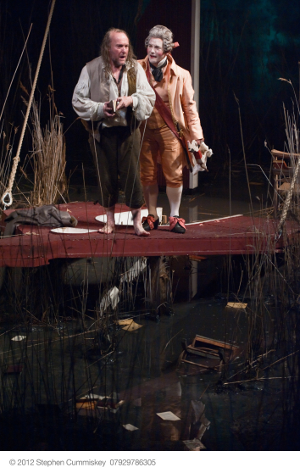 Andrew Shore as Jakob Lenz and Richard Roberts as Christoph Kaufmann
Andrew Shore as Jakob Lenz and Richard Roberts as Christoph Kaufmann
But what music it is! Intensely atmospheric, almost pictorial. Oboes, bass clarinets, bassoon and cellos, moaning ominously like wind in the reeds, echoing the otherworldy choruses. A harpsichord screams in shrill desperation. Hollow wooden tapping, muted percussion like frantic heartbeats. Sudden cries from small trumpet. Strings plucked and beaten, sounds half heard from beyond the auditorium. Hearing Rihm’s Jakob Lenz audio only can drive you crazy, but that’s the point. Lenz is an artist. Oberlin isn’t, though he’s nice. Must artists be driven like Lenz is? Imagination is powerful because it hints at more than it tells.
Performance of a lifetime from Andrew Shore as Jakob Lenz, with strong support from Jonathan Best, Richard Roberts and Suzy Cooper, plus good chorus and actors. This isn’t an opera or a production for those who think Rusalka should be a pretty fairy tale, but it’s like a fairy tale in that it deals with subjects that can’t be easily explained. Georg Büchner’s original play (1836) treated psychosis in a modern, non-judgemental way. Generations before, Jakob Lenz might have been burned as a male witch. Büchner tries instead to understand, and Rihm gets us inside Jakob Lenz’s head, so we might feel as he does. It’s not comfortable, but most definitely important. Sam Brown is the director, Annemarie Woods the designer. For bringing Rihm’s Jakob Lenz to London, the ENO deserves every accolade.
Anne Ozorio
image=http://www.operatoday.com/Jakob_Lenz_Andrew_Shore_Jonathan_Best_c_Stephen_Cummiskey.png
image_description=Andrew Shore as Jakob Lenz and Jonathan Best as Joihann Freidrich Oberlin [Photo by Stephen Cummiskey courtesy of English National Opera]
product=yes
product_title=Wolfgang Rihm: Jakob Lenz
product_by=Jakob Lenz: Andrew Shore; Johann Freidrich Oberlin: Jonathan Best; Christoph Kaufmann: Richard Roberts; Friederike Brion: Suzy Cooper; Voices: Rebecca van den Berg, Alexa Mason, Sigridur Osk, Louise Collett, Jimmy Holliday and Barnaby Rea. Children: Eleanor Grant, Harry Foster, Lillie Forrester. Director: Sam Brown. Designs: Annemarie Woods. Lighting: Guy Hoare. Movement: Anjali Mehra. Conductor: Alex Ingram. English National Opera. Hampstead Theatre, London, 17th April 2012.
product_id=Above: Andrew Shore as Jakob Lenz and Jonathan Best as Joihann Freidrich Oberlin
Photos by Stephen Cummiskey courtesy of English National Opera
Folk songs that aren’t folk songs
Fink is the foremost Dvořák mezzo around. Her recordings (some with Roger Vignoles) are benchmarks. So it was a surprise that the Wigmore Hall wasn’t packed out. Maybe it was the Friday 13th factor, maybe it was Easter when people are out of London. Perhaps, ironically, it was the simple fact that Fink’s Dvořák and Brahms are so well known; audiences forget how live performance is nothing like recording. Fink is a natural recitalist (not all singers are, even if they’re good). She smiled graciously and sang as if she was singing for a private gathering of friends. That’s aplomb! Dvořák and Brahms songs aren’t meant for flashy display. Bernarda Fink makes them feel personal, as natural as one-to-one conversation.
The recital was preceded by a talk by Professor Jan Smaczny. Talks and programme notes these days are often inept filler, but Smaczny is in an altogether different league. He’s a genuine scholar with first hand, original knowledge. He speaks about Dvořák’s manuscripts with the authority of someone who knows them well. “Dvořák used them like a diary, noting daily events in the margins”. Many Czech specialists don’t communicate well in English, so our perceptions are shaped by anglocentrism. Smaczny understands the context of Czech culture and Dvořák’s part in the evolution of Czech music. We don’t hear Smaczny often enough in London but should. This is the sort of quality the Wigmore Hall should embrace.
Dvořák’s orchestral music is permeated by his affinity for song. As Smaczny says, songs “were pivotal to his developing musical style, and frequently gave notice of important changes of direction in his expressive language”. Thius it was good to hear Fink and Vignoles start with Dvořák’s Six Songs From the Queen’s Court Manuscript op 7 (1872). The texts were based on what were believed to be authentic medieval sources, but were modern invention. No matter, for they inspired awareness of Czech national identity. The poems are pastoral, like imitation folk song. Gentle, rolling piano creating a pleasant background to the sharp sibilants in the words. The warmth in Fink’s voice complements the images of summer and youth, yet she catches the undertones of sorrow. Sensucht, one might say if the songs were German.
Yet in the last song, “Jahody” (Strawberries) Dvořák becomes much more adventurous. Fink captures the strange unresolved tension in the first strophe. A girl has been gathering strawberries but a thorn has cut her foot and it’s infected. She can’t walk and her lover is angry. The piano part describes his impatience and the sound of his horse galloping off, taking the lovers to another place where they snatch a few moments of love, before dashing home again. With its sudden changes of pace and mood, the song is unsettling, almost a miniature opera. Fink expresses the urgency and fear that makes the song dramatic, without overdoing the “voices” or excess histrionics.
Brahms’s Deutsche Volkslieder (publ 1894), are similarly art song masquerading as folk song, so Fink and Vignoles performed four songs, a sample of Brahms’s two large collections of Volkslieder that aren’t actually Volkslieder. Mature Brahms and early Dvořák don’t really compare, but Fink and Vignoles followed these with five of the ten Dvořák Biblical Songs from op 99 (1894) (no.s 1, 2, 3, 8 and 10) to even the score. One instinctively thinks of Brahms’s Vier ernste Gesänge (op 121 1897) which of course was written for low baritone, That’s an idea, programme them together with different singers.
Bernarda Fink has made Dvořák Five Biblical Songs one of her trademarks. She sang it at the high profile Dvořák anniversary concert in Prague Castle in 1991. (read more here and listen to a clip). She’s sung these songs many times at the Wigmore Hall, so if her performance on this occasion wasn’t as compelling as usual, it evoked many good memories.
It was good to hear how Slovenian contemporaries of Brahms and Dvořák approached song in their own language. From what we heard this evening, Benjmin Ipavec (1829-1908) and Anton Lajovic (1878-1960) wrote pleasant though undistinguished Biedermeyer. Lucilan Škerjanc (1900-1973) though, is more cosmopiltan and original. In “Evening Impression”, Fink’s sensitive phrasing and upward soaring lines created emotion and shape. The poem, by Igo Gruden is lovely, even in translation. Fink and Vignoles make a case for it as mainstream repertoire. To hear more, there’s a recording by Fink and her brother Marcos ( a bass baritone), both native speakers, on Harmonia Mundi.
Fink and Vignoles performed another set of Brahms songs, including the wonderful Von ewiger Liebe (op 43/1 1894) before returning to Dvořák In Folk tone (op 73, 1886). Perhaps Fink had been waiting for them, since her singing now moved from attractive to truly inspired. These songs are sophisticated in the best sense. Moods change swiftly, hinting at submerged meaning, tantalizing the listener. Fink’s keening legato gave the first song, a lullaby, a searching edge that made one realize it wasn’t about a baby. The piano part, too, is unashamedly sensual. In the second song, a girl is scything and sees her forner lover. The piano sounds bright and optimistic, but the vocal part breaks into strident staccato “Šuhaj, šuhaj z druhej strany”. She taunts him fiercely, but inside her heart is breaking. Fink repeats the final line “už si v mojom srdci riastla” wistfully, with great tenderness. Simiarly, the lilting piano in the third song sounds happy, but the firm deliberation in Fink’s voice suggests that this steel has been forged through fire. More defiance still, in the final song where the piano prances like the swift pony. Fink’s voice dances along too, but Dvořák uses the sharp Czech sibilants to suggest the “arrow” which cuts through the lover’s heart.
Anne Ozorio
image=http://www.operatoday.com/Fink.png
image_description=Bernarda Fink [Photo by Klemen Breitfuss courtesy of machreich artists management gmbh]
product=yes
product_title=Wigmore Hall Dvořák Series — Dvořák, Brahms, and Slovenian Songs
product_by=Bernarda Fink, mezzo-soprano; Roger Vignoles, piano. Wigmore Hall, London, 13th April 2012.
product_id=Above: Bernarda Fink [Photo by Klemen Breitfuss courtesy of machreich artists management gmbh]
Armide, Opera Atelier
Possibly the finest opera of the 17th Century, and certainly one of the greatest operas ever written, it’s almost completely unknown to most people.
Why see it again, and why should you see it?
Forget what you think baroque opera is supposed to do. Instead of the alternation between recitatives and arias, singers showing off their skills with elaborate coloratura and high notes that stop the story in its tracks, Lully’s arioso writing keeps moving, often punctuated by dance, and avoiding the stasis one finds in an Italian baroque aria.
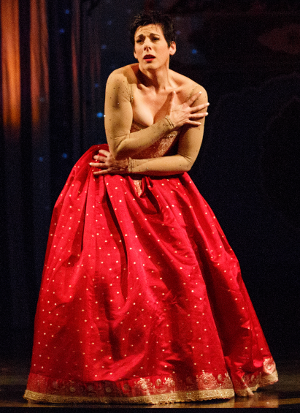 Peggy Kriha Dye as Armide
Peggy Kriha Dye as Armide
Armide is a story of love and duty. Set in the Crusades, Armide is an Islamic Princess, while Renaud, her chief antagonist — and eventually her lover — is a Christian Knight. The story elicits so many odd moments of personal conflict and ambivalence that when Jean-Luc Godard set passages from the opera in the film Aria, they illustrate a kind of misogynistic torment of women that seems to lead to madness. I don’t encourage you to see Godard’s film, at least until you’ve encountered the work as written.
Watching the opera tonight I thought of a film with a similar offbeat mythology, namely Mr & Mrs Smith, a story about a husband and wife who are hired killers. For awhile in the film they try to kill each other, not so very different from the antagonism one sometimes experiences in marriage, but taken to a comical extreme.
Or as Pat Benatar tried to tell us, “love is a battlefield”.
That metaphorical understanding of the opera’s epic battles — in other words, that Armide is less a matter of crusading and more a matter of loving — is the key to the new production. In OA’s previous take on Lully’s opera, at least in what Director Marshall Pynkoski spoke of in his notes– they seemed to focus mostly on the politics, so that it ended on an anti-climax, as Armide was abandoned by her lover Renaud.
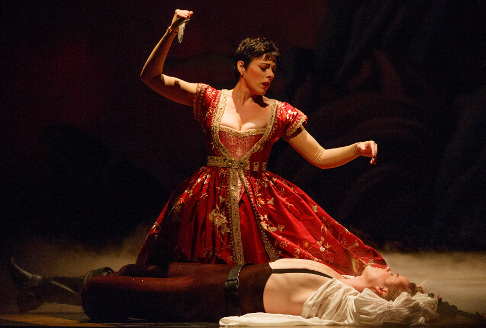 Peggy Kriha Dye as Armide and Colin Ainsworth as Renaud
Peggy Kriha Dye as Armide and Colin Ainsworth as Renaud
This time Pynkoski paid less attention to matters of state and instead concentrated on matters of the heart. In Lully’s style of opera, dance is integral to the action, and so it’s no wonder that choreographer Jeannette Lajeunesse Zingg was involved more in Armide than perhaps any previous opera from OA.
Dancer Jack Rennie is the most memorable personage in the work (even without singing), playing the figure of Love. For awhile Armide seeks to escape from love, and enlists the aid of Hate, a demonic figure from Hell, to exorcise Love from inside her. The small part of Hate was memorably sung by Curtis Sullivan. Hate brings demons to torture Love, but in the end Armide chooses Love and rejects Hate (which makes him even angrier).
Both leads were outstanding. Colin Ainsworth as Renaud reprised the role he sang in the previous production, every note exactly on pitch. The voice is as gentle and sweet sounding as ever, but seems to have grown bigger. Peggy Kriha Dye as Armide has a far more difficult part to play. Where Renaud has to mostly look heroic and then fall in love, Armide is a far more ambivalent character of contradictory passions. The dramatic highlight of the evening was Dye’s scene when she comes upon the sleeping Renaud, intending to kill him.
This sequence — complete with daggers — might be why Jean-Luc Godard decided to show Armide as a window on the oppression of women, with his chief insight being that love makes women crazy. We saw Dye’s portrayal change from the confident attacker, seduced by Ainsworth’s vulnerable form, and tormented by indecision, finally incapable of striking.
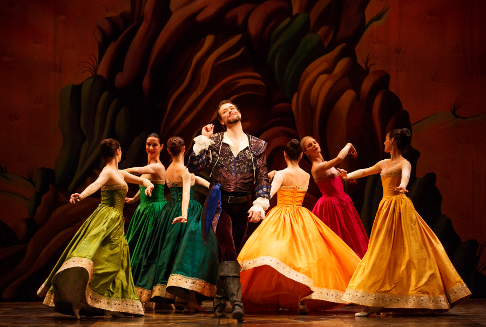 Olivier LaQuerre as Chevalier Ubalde and Artists of Atelier Ballet
Olivier LaQuerre as Chevalier Ubalde and Artists of Atelier Ballet
The throbbing heart of the production is Tafelmusik Orchestra led by David Fallis. Singers were never covered, but always supported sensitively, even though the score is full of drumming and strong rhythms reminiscent of military music. The other highlight came unexpectedly from Tafelmusik Chamber Choir, in a sequence where we are being told about the delusory nature of reality. The music is a delightfully sensual lure, even as the text tells us otherwise.
Designer Gerard Gauci’s lovely sets are more elaborate than before, in anticipation of being toured first to Versailles Theatre, and then Glimmerglass for the summer.
But first they’ll finish out the week at the Elgin Theatre until Saturday April 21st.
Leslie Barcza
This review is reprinted from Barcza Blog with permission of the author.
image=http://www.operatoday.com/Armide_FINAL.png image_description=Marie McDunnough and Jack Rennie, Artists of Atelier Ballet [Photo by Bruce Zinger courtesy of Opera Atelier] product=yes product_title=Jean-Baptiste Lully: Armide product_by=Click here for cast and production information. product_id=Above: Marie McDunnough and Jack Rennie, Artists of Atelier BalletPhotos by Bruce Zinger courtesy of Opera Atelier
Il Sogno di Scipione
It is also unclear how much of Sogno was ever performed in Mozart’s lifetime—very little, apparently. The piece’s modern revival, possibly world premiere, took place in 1979 with a cast (recorded) whose luxe is hardly imaginable for such a project today: Popp, Gruberova, Mathis, Schreier, et al.
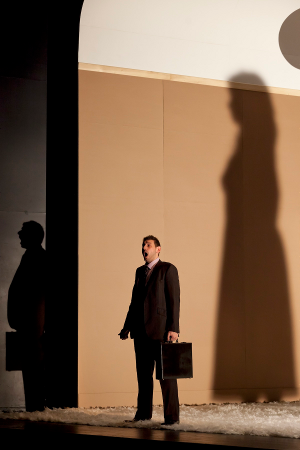 Michele Angelini as Scipione
Michele Angelini as Scipione
The text is a moralizing serenata by the indefatigable imperial court poet Metastasio (only his death, after half a century on the job, left the Viennese post to Lorenzo da Ponte). He drew it from Cicero’s moralizing fable of the younger Scipio Africanus choosing (in a dream) virtue over pleasure in the fine old Roman republican manner, thus putting to shame the decadent Romans of Cicero’s later era when the republic was dying. Metastasio made the choice between Good Luck (Fortuna) and Self-Discipline (Constanza), and of course Scipio chooses the latter, though not without Fortuna getting to make her case pretty well. Sententious sentiment made the libretto ideal for formal occasions, such as the investment of a new archbishop, but rather a stretch in the theater. I saw it at the Residenz-Theater in Munich in 1991 (on a double-bill with Mozart’s Apollo und Hyakinthos); the exquisite jewel-box theater considerably outshone the music. Neal Goren, of Gotham Chamber Opera, claims that when he started his company ten years ago, he slyly told Christopher Alden that there was a Mozart opera that had never been staged in this country (true) and that it was regarded as unstageable. Alden, naturally, took this as a challenge. To celebrate ten felicitous years, Gotham has revived his brilliant opening, which I missed at the time.
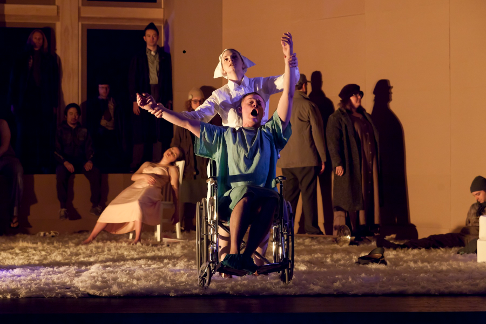 Cast of Il Sogno di Scipione
Cast of Il Sogno di Scipione
The production’s Regie-theater clichés must, in 2001, have been as startling to a New York audience as Goren hoped they’d be. They still make the audience laugh—and remain attentive. The curtain rises in heaven, a bare bedroom, and Scipio wakes scratchily from a doze to find himself literally between the sheets between two goddesses, from whom he must choose one. (At last Friday’s performance, Fortuna has gone to bed with filthy feet. I have no idea whether this was part of the director’s vision.) Fortuna presents herself as fickle but fun by doing a reverse striptease, pulling assorted outfits from a closet and trying them on for us. (Shoes! Tops! Wigs!) Constanza never sheds her nightdress but she invokes the Music of the Spheres, impersonated by globular hanging lamps. A chorus of dead heroes appears at the window in assorted deadbeat garb, echoes from a zombie movie. (Scipio, terrified, climbs on the wardrobe to escape them.) Scipio’s father (Publio, an amputee in this version) and grandfather (Emilio, wheelchair-bound and blind) show up to remind the lad of the glories of public service, in arias that Mozart cannot have intended to possess the ironic air Alden’s staging gives them. At last, though spooked, Scipio chooses Constanza (the path of duty), Fortuna is frustrated, and an Epilogue (Licenza) appears to warble the best tune of the night, congratulating the audience (in Mozart’s day, the Archibishop; nowadays, us) for having the taste to admire this sublime entertainment. Alden’s Licenza demonstrates her enthusiasm by tossing disco moves into her coloratura ecstasies.
All of this activity and ironic subtext-as-commentary-within-action undoubtedly gives the score a better chance of being appreciated than it would ever secure if performed “straight.” Doubt crept in during the more elaborate vocal displays—the piece was written for vocal display, illustrating and underlining the meanings of the text, and as the intended first cast were Salzburg singers, Mozart knew just what they could do. The young singers performing for Gotham Chamber Opera were all of them more than qualified to do justice to Mozart, personable, talented actors as well. But none of the performances was entirely on the mark, coloratura were often uneven, a little tuneless or imprecise, and it was impossible to suppress the notion that they’d have sung better if there had been less wriggling about (or tottering, in the case of amputated Publio, or clambering up the walls of the armoire in the case of Scipio, or thrash-dancing in the case of Licenza). It was an occasion of colorful performing but the Mozart-singing suffered for it.
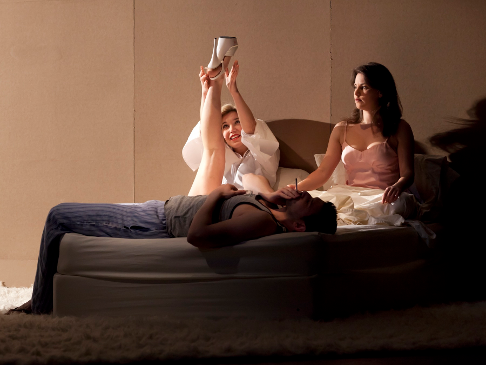 Susannah Biller as Fortuna, Michele Angelini as Scipione and Marie-Ève Munger as Constanza
Susannah Biller as Fortuna, Michele Angelini as Scipione and Marie-Ève Munger as Constanza
The two most interesting voices, the ones that made me eager to hear them again in less athletic circumstances, belonged to Michele Angelini as dreaming Scipio and to Maeve Höglund as Licenza. Angelini possesses a baritonal tenor, an agreeable sound of masculine depth and a happy instinct for phrasing, plus an easy extension to an agreeable lyric top. One foresees enjoying him as Idomeneo or Belmonte. Höglund had the most sensuous voice of the bunch, a soprano with mezzo undertones, luscious and sensuous in a text that lacked seductive implications but seemed to have them when she put it over. Susannah Biller’s Fortuna was flashy, sometimes to strident effect. Marie-Ève Munger’s Costanza was altogether more cozy, but then it can’t be easy to impersonate something so stolid with any flare. Arthur Espiritu and Chad A. Johnson were effective as the ghosts of Scipio’s family past. Neal Goren led a very spirited orchestra and chorus, and nearly two hours passed as harmoniously as Ptolemy the Astronomer could have demanded.
John Yohalem
image=http://www.operatoday.com/RT_MG_0365_1.png image_description=Susannah Biller as Fortuna [Photo by Richard Termine courtesy of Gotham Chamber Opera] product=yes product_title=W. A. Mozart: Il Sogno di Scipione product_by=Constanza: Marie-Ève Munger; Fortuna: Susannah Biller; Licenza: Maeve Höglund; Scipione: Michele Angelini; Publio: Arthur Espiritu; Emilio: Chad A. Johnson. Chorus and orchestra of the Gotham Chamber Opera, conducted by Neal Goren. Production by Christopher Alden. At the Gerald W. Lynch Theater at John Jay College. Performance of April 13. product_id=Above: Susannah Biller as FortunaPhotos by Richard Termine courtesy of Gotham Chamber Opera
April 18, 2012
Financial Crisis at Köln
By Frank Cadenhead [Opera Today, 18 April 2012]
On Tuesday evening, Cologne Opera’s director indicated he was planning to cancel the next season, 2012-2013. Intendant Uwe Eric Laufenberg, frustrated by the failure of the city to resolve financing issues, noted that would be the first time any German house cancelled it’s entire season since the darkest days of the Second World War. The announcement of the new season was planned for next Monday.
Cologne Opera to Cancel Next Season?
Intendant Uwe Eric Laufenberg, frustrated by the failure of the city to resolve financing issues, noted that would be the first time any German house cancelled it’s entire season since the darkest days of the Second World War. The announcement of the new season was planned for next Monday.
One of the principal houses in Germany, the company was forced to move five million Euros from its reserves to complete the current season. the City Council has approved the budget expenditures “in principle” but, Laufenberg notes, the funds are still not accessible. Contracts for artists and other expenses cannot be completed without a resolution. “All persons involved must now quickly find a solution,” Laufenberg said.
Frank Cadenhead
image=http://www.operatoday.com/Oper_Koeln.gif
image_description=Oper Köln
product=yes
product_title=Cologne Opera to Cancel Next Season?
product_by=By Frank Cadenhead
product_id=Above: Oper Köln
April 17, 2012
Xu Zhong Tapped by Teatro Massimo Bellini
By Frank Cadenhead [Opera Today, 17 April 2012]
The Chinese conductor and pianist Xu Zhong will be the new artistic director of an Italian opera house, the Teatro Massimo Bellini in Catania. He was well received when he conducted the theater’s orchestra a few weeks ago as part of their symphonic season and has regularly appeared on international stages.
Chinese Conductor to Lead Italian Opera
He was well received when he conducted the theater’s orchestra a few weeks ago as part of their symphonic season and has regularly appeared on international stages.
He succeeds maestro Will Humburg who resigned in December. “I am greatly honored by this appointment, because this is the first time a Chinese conductor has come to Italy to direct a theater with a great tradition such as the Massimo Bellini,” Zhong declared.
Xu Zhong was the founder and director of the International Piano Competition of Shanghai and artistic director of the Shanghai Philharmonic. He lis also principal guest conductor of the KBS Symphony Orchestra in Seoul, South Korea.
Frank Cadenhead
image=http://www.operatoday.com/Xu_Zhong.gif image_description=Xu Zhong product=yes product_title=Chinese Conductor to Lead Italian Opera product_by=Frank Cadenhead product_id=Above: Xu ZhongTenor Loses Steak, Saves the Concert.
By Frank Cadenhead [Opera Today, 17 April 2012]
Tenor Johan Botha had just started carving his steak when his phone rang. A director of Vienna’s Gesellschaft der Musikfreunde was on the line with an emergency request. On March 29, at the famed Musikvereinsaal, Zubin Mehta and the Munich Philharmonic were to set to begin the concert’s second half, the imposing Das Lied von der Erde of Gustav Mahler.
Mishap at the Musikfreunde
On March 29, at the famed Musikvereinsaal, Zubin Mehta and the Munich Philharmonic were to set to begin the concert’s second half, the imposing Das Lied von der Erde of Gustav Mahler.
Minutes before the end of the intermission, the scheduled tenor Thorsten Kerl suddenly began to experience pain and dizzy spells. Botha, having this work in his repertory, agreed to help and flagged a cab. He arrived after baritone Thomas Hampson had already began the symphonic song cycle. He sang the three tenor movements and the audience rewarded Mehta, Hampson and Botha with “thunderous cheers” according to the Viennese press.
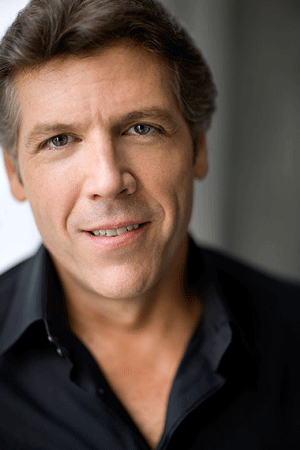 Thomas Hampson [Photo courtesy of Centre Stage Artist Management]
Thomas Hampson [Photo courtesy of Centre Stage Artist Management]
Kerl has recovered from his indisposition and the Gesellschaft der Musikfreunde (Society for Friends of Music) has another anecdote for their 200th anniversary year.
Frank Cadenhead
image=http://www.operatoday.com/Johan_Botha.gif image_description= product=yes product_title=Mishap at the Musikfreunde product_by=By Frank Cadenhead product_id=Above: Johan Bothan [Photo courtesy of Michael Lewin International Artists’ Management]April 16, 2012
The Dream of Gerontius, Barbican Hall
He later said that ideas for a setting had been “soaking in my mind for at least eight years” when he set about preparing a libretto for a new work to be performed at the 1900 Birmingham Festival. At the end of the score Elgar inscribed words from Ruskin: “this is the best of me”. Unfortunately, technical deficiencies and inadequate rehearsal resulted in a less than satisfactory first performance, leading the composer to despair, “I always said God was against art … I have allowed my heart to open once - it is now shut against every religious feeling and every soft, gentle impulse forever”. A little melodramatic perhaps … but a sign of Elgar’s complex and at times troubled faith, and of the work’s importance to him.
Preparations for this performance by the City of Birmingham Symphony Orchestra and Chorus were not entirely smooth either, with both conductor, Andris Nilson (owing to a family illness), and tenor Toby Spence forced to withdraw in the preceding days. However, under the baton of the CBSO’s principal guest conductor, Edward Gardner, and with Robert Murray stepping into Gerontius’ shoes, there was certainly no danger of a repeat of the chaotic premiere. In lesser hands, this intricate, mysterious work can become muddy and messy; Gardner summoned from his performers a controlled piece of musical drama that captured both the work’s theatricality and its poetry.
Robert Murray has the vocal resources to meet the considerable demands of the role; his voice pleasingly balanced restraint and passion, and he was consistently attentive to the dynamic markings, though never slavishly so, bringing genuine expressivity to moments of power and poignancy. Although a little diffident at the start, Murray had the confidence to trust his introspective reading, and not to indulge in excessively showy operatics. His upper range possesses emotive impact; he has the power to carry above even the most surging orchestral passages without undue strain, but also the poise to float the quietest pianissimo. He conveyed the old man’s restless anxiety in Part 1 when facing death, and displayed rhetorical vigour in his heroic prayer for God’s strength “Sanctus fortis, Sanctus Deus”. And a sonorous intensity marked the Soul’s climactic cry, “Take me away, and in the lowest depth there let me be”.
Murray’s Part 2 duet with the Angel, sung by Sarah Connolly, took a little while to get into its stride, but was moving and convincing. As the Angel guides Gerontius’ soul, Connolly’s rich, burnished mezzo combined strength and tenderness, expressing profound sentiment but never sentimental. She has a strong lower range, and the text was thoughtfully nuanced. The Angel’s farewell blessing at the close of Part 2 was truly beautiful — open, warm and full of hope and promise. And, after the work’s emotional storms, the composure of Connolly’s full-toned final lullaby, “Soft and gentle, dearly ransomed Soul” brought a satisfying equanimity.
Fittingly dramatic interventions were made by James Rutherford, first in his stirring invocation as the Priest at the close of Part 1, “Proficiscere, anima Christiana, de hoc mundo! Go forth upon thy journey, Christian soul”, as Gardner drove forward with a thrilling accelerando, and later as the Angel of Agony at the corresponding conclusion to Part 2. Rutherford’s weight of tone and long-breathed phrasing added much liturgical authority and gravity.
All three soloists displayed a sure appreciation of Elgar’s declamatory, arioso style, allowing the musical phrases to breathe while retaining a naturalistic accentuation of text.
Gardner was totally in command of the work’s motivic complexities, tonal ambiguities and flexible formal qualities. From the hushed beginnings of the Prologue, he crafted a seamless orchestral tapestry: as clarinets, bassoons and violas introduced the plaintive opening theme, initially unaccompanied and then supported by pensive double basses and low woodwind, the symphonic seeds from which the work unfolds were made evident. Gardner never allowed the orchestral forces to overwhelm the singers but ensured too that that his players did not take second place, that the instrumental voices were equal partners in the musical conversation, involved in the expressive drama and commentating on the action. On a few occasions — in the Prelude and building to the climactic “Take me away” - the tempi seemed a little on slow side, but Gardner did successfully build momentum in the climactic passages. He is at home with the theatricality of the work but, while he did not miss a single gesture or intimation in detailed score, he was never melodramatic.
Elgar makes huge demands upon the chorus, and the CBSO Chorus assuredly rose to the challenge, mastering the contrapuntal complexities, displaying depth of tone and rhythmic vitality, and articulating the words with clarity. They convincingly adopted a variety of roles and explored a range of colours: as Gerontius' ‘Assistants’ praying earnestly by his bedside in a burial chorus, their appeals to God to “Rescue him … in this his evil hour” were vibrant and energised; in contrast, the sopranos’ closing invocation in Part 1, “And may thy place today be found in peace … through the Same, through Christ Our Lord” was shimmering and translucent. A pure, centred tone characterised the Part 2 Chorus of Angelicals, “Praise to the Holiest in his height”, beautifully shaped phrases enhanced by the gentle harp accompaniment.
The Demons’ Chorus was a tour de force: powerful unisons above whirling strings and flashing piccolo shrieks made great impact, as during a vigorously exchange with the orchestra, Gardner crafted impressive motivic coherence. Here, as throughout, vividness was never achieved at the expense of clarity and accuracy.
This performance attained rich emotional depths. Religiosity was balanced with humanity, as in moments such as the Assistants’ imploring appeal, “Be merciful, be gracious, spare him, Lord”, where the strained timbre of the violins’ high G-strings possessed both an eloquent power and intimations of human frailty.
The most electrifying moment in the work comes as the Soul finally departs, to be “Consumed, yet quickened, by the glance of God”. Here Gardner conjured a thrilling crescendo, building to an awe-inspiring climactic discord from the full orchestra complemented with organ and percussion. The moment of insight is brief — a dazzling but momentary glimpse of truth — followed by stillness, as the sforzando eruption gives way instantly to a tremulous pianissimo. In this blinding moment, simultaneous conveying both faith and doubt, Gardner and his performers fully captured the universality of Elgar’s message.
Claire Seymour
image=http://www.operatoday.com/Sarah_Connolly.png image_description=Sarah Connolly [Photo by Peter Warren courtesy of Askonas Holt] product=yes product_title=Edward Elgar: The Dream of Gerontius product_by=Sarah Connolly, mezzo-soprano; Robert Murray, tenor; James Rutherford, bass-baritone. City of Birmingham Symphony Orchestra and Chorus. Edward Gardner, conductor. Barbican Hall, London, Saturday, 14 April 2012. product_id=Above: Sarah Connolly [Photo by Peter Warren courtesy of Askonas Holt]April 15, 2012
Opéra Comique’s Muted Auber
The eight doors confronting us at curtain rise (nine with the huge floating door upstage, but who’s counting?) were somehow intended to help visualize Auber’s ground-breaking Granddaddy of All Grand Opera. Not that scenic artists Carmine Maringola and Vanessa Sannino completely fail in their intentions, it was just a frustratingly unspecific start with a structurally muddled playing space for a piece that calls for such highly detailed Neapolitan locales and effects as, well, the eruption of Mount Vesuvius to name but one.
While the individual door wagons were rolled around by (almost) unseen supers, they seemed to be choreographed more for intentional distraction than coherent dramatic purpose. What the heck was that door doing on the fishing docks, for one thing? And why did the leading tenor and bass jump on the unit and get spun around by the extras at duet’s end?
Otherwise, the use of rippling drapes to suggest the balmy atmosphere of the seaside provided an apt environment (at least until that errant door intruded stage left). That said, the veiled opening of the act with the half-dressed male extras cavorting about rather intimately behind the gauze had just a hint of ‘Twink Night at the Continental Baths’ about it. But there was also effective use of an enormous red banner that flies in, becoming not only the backdrop for the church wedding’s suspended crucifix, but continuing to unfurl, creating a red carpet running from far up- to far down-stage. Much is made of such imagery: the fisherman drag and perform synchronized gathering and unrolling of oversize nets; they cast and re-coil nautical ropes; and they deploy an incredibly long wedding veil to create a series of canopies through which the titular heroine darted to and fro rather madly.
There was a commendably consistent train of creative thought at work here that more often than not rang true. Or true enough. I have to say that the re-appearance of the eight rolling doors in the palace scene, now re-dressed and tufted with red velvet, made us roll our eyes with an “oh-that-again” sense of resignation. Although I quite liked the addition of the well known paintings of Spanish royalty which flew in to frame the action. And since confession is good for the soul, when the poor mute swathed herself in the bolt of copious red carpet as she graphically communicated the tale of her abduction I did fleetingly, churlishly try to work out some witticism around “The Drape of the Sabine Women.”
The only utter miscalculation of the setting was the finale in which the heroine is meant to commit suicide by hurling herself into the erupting volcano. Or second best concept, into a lava flow. Third best, I nominate a Senta-like suicide into the Mediterranean. But the production team was having none of this and instead the girl mounted stairs (so far so good) and then disappeared behind a drape. When it lifts, she is revealed in stasis decked out as a primitive Virgin Mary of the gaudy simplicity reserved for South American folk museums. Hard to conjure up any subtext that would suggest any eruption, literal, figurative, or even absurd. It just didn’t play.
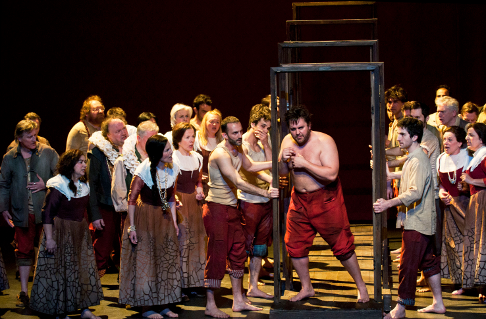
Ms. Sannino’s variable costumes were all over the map, excepting perhaps Portici. The men were rather generic peasants, everyone barefoot. The ladies later followed suit, but began the show in period hoop skirts with peek-a-boo draping revealing the hoop frame as well as legs in brightly colored tights. Then there were the curious life-sized Spanish lady porcelain dolls-on-wheels, each of whom, instead of legs, have a miniature Spanish male royal seated on a throne under her skirts (make up your own comment). The principals were rather more traditional nobility in richly detailed costumes. Lighting designer Dominique Bruguiere has created some decent effects, but should be cautioned to always ensure we see the leading singers’ faces.
Easily, the star performance of the night was from actress-dancer Elena Borgogni as a febrile, feline, coiled spring of a mute Fenella. From the moment we entered the auditorium she was prowling the apron of the stage like a caged animal. Her indefatigable energy and focused intensity were palpable every second she was in view. Her re-living of the abduction was raw and highly affecting. I cannot imagine a finer impersonation. ‘Electric’ and ‘mesmerizing’ seem to fall short in describing her accomplishment.
Eglise Gutierrez arguably brought the biggest reputation to the production, having sung major roles at respectable houses. On my first encounter with her, I found the voice to be veiled, somewhat restricted, and without much presence in the lower reaches. Coloratura in the upper third of the instrument made its mark, but it got smudgy as the line descended. But while she started off with limited vocal color, she was nonetheless a vibrant star presence. Her medium-sized lirico-spinto freed up substantially as the evening progressed and by Act Four Ms. Gutierrez was firing on all cylinders turning in a personalized and truly moving account of her aria.
Maxim Mironov was a perfectly decent Alphonse, his pleasing slender tenor showing off a sound technique and encompassing the role’s requirements with ease and acumen. Laurent Alvaro was a menacing, compelling Pietro, his ripe dark bass-baritone ricocheting through the house. In fact, at first I thought he might be over-singing until I realized that down stage left is an acoustic “hot spot” with everyone sounding almost ‘amplified’ from there. Mr. Alvaro sang with full-throated abandon when needed, but also with sensitive musicality and nuanced phrasing.
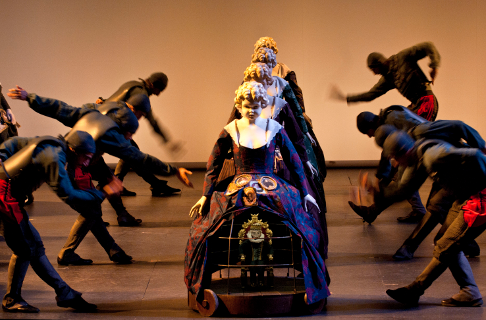
Rising star tenor Michael Spyres finally came on stage in Two and immediately elevated the entire performance by a notch (or two or three). First, he ‘gets’ French style and is as good at it as anyone currently in the business. And then there is the beauty and richness of his substantial lyric tenor itself. He has the high-flying top notes to be sure, but a real glory of his singing to me is the robust presence of his lower register and his accomplished presentation of the parlando phrases. Mr. Spyres seemed to be pacing himself in the sustained upper reaches at times, but the voice is freely and clearly produced in all registers and at all volumes. His extended aria featured some exquisite ‘piano’ passages although he is still finding his way through (just) a few less steady moments. Time and experience will even all that out. Michael is young, he is talented, and he is making a serious case for ownership of this repertoire.
In smaller roles, the house cast them from strength with Tomislav Lavoie intoning a solid Borella, Jean Teitgen contributing a memorable and characterful Selva, and Martial Defontaine showing off a substantial baritone as Lorenzo.
Stage Director Emma Dante produced mixed results, meandering through undefined scenes one minute and knocking our socks off the next. In general the interaction of the principals was woefully underdeveloped with much sung straight forward, and the singing chorus was often too unengaged, or in the case of the opening chorus, not even on stage! But then there was the highly detailed, meticulous direction of Fenella. And the often thrilling incorporation of the corps of male dancer-actors-extras that, when they were good, were truly great.
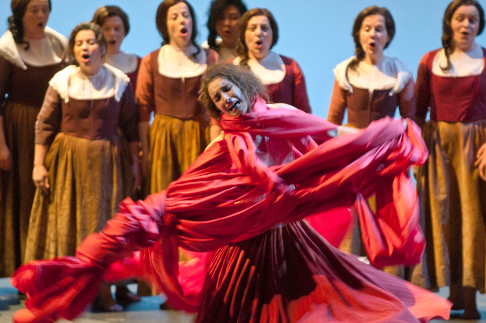
Indeed, the character-based, non-balletic dance staging by Sandro Maria Campagna was one of the most consistently exciting production elements. Eschewing the traditional classical ballet approach, the assembled group of men were earthy, primordial, and threatening. Their group dynamic informed the entire show, and provided a brutal provocation to goad Fenella’s neurotic terpsichorean outbursts. The quasi-folk steps the boys execute are athletic and passionate. And in a stunning visual coup, as the battle ensues in Act Three, these men, violently wounded, brutally killed fell to the floor, shucked their clothes and twitched like Bonnie and Clyde being riddled with bullets until they lay stone dead. This imagery of the shedding of earthy trappings and ultimate repose was not something I will soon forget.
Ms. Dante capitalizes further on this moment by having the abused Fenella pass through the killing field and shut the unseeing eyes of the corpses who are now unable to harm her further, as the chorus intones the melting a capella prayer. I urge our director to infuse the rest of the proceedings with this same intense, clear-headed vision. Moreover, I dearly wish the entire team could imbue the piece with a truer sense of time and place that Auber deserves.
For his part, Patrick Devan conducted at first with commendable precision and efficiency if little give and take. But he soon became more involved and accommodating, eliciting ever more detailed and expansive playing from the pit. The responsive orchestra and full-throated chorus were from Brussels’ Theatre Royal de La Monnaie who co-produced.
La Muette de Portici, with its populist sentiments, of course literally sparked a revolution when it premiered in the Belgian capital. I am not sure the current embodiment may have the same effect, In fact, perhaps Auber’s greatest accomplishment was having inspired everything (better) that followed. My one and only other experience with the piece was an enjoyable enough outing in Wiesbaden, Germany in the early 1980’s. I have come to think that seeing “La Muette de Portici” every thirty years is, well, quite enough.
James Sohre
image=http://www.operatoday.com/Muette_01.png
image_description=Scene from La Muette de Portici [Photo by E. Carecchio courtesy of Opéra Comique]
product=yes
product_title=Daniel-François-Esprit Auber: La Muette de Portici
product_by=Fenella: Elena Borgogni; Alphonse: Maxim Mironov; Elvire: Eglise Gutierrez; Masaniello: Michael Spyres; Pietro: Laurent Alvaro; Borella: Tomislav Lavoie; Selva: Jean Teitgen; Lorenzo: Martial Defontaine; Conductor : Patrick Devan; Director: Emma Dante; Set Design: Carmine Maringola; Set and Costume Design: Vanessa Sannino; Lighting Design: Dominique Bruguiere; Choreography: Sandro Maria Campagna; Orchestra and Chorus of the Theatre Royal de La Monnaie.
product_id=Above: Scene from La Muette de Portici
Photos by E. Carecchio courtesy of Opéra Comique
April 13, 2012
Alfredo Catalani — A new perspective on later Italian opera
Catalani is the nearly man of late 19th century Italian opera. Where contemporaries such as Giordano and Cilea hang on to the fringes of the repertoire with a single opera, Catalani is famous for just a single aria, ‘Eben? Ne andro lontano’ from La Wally. But Catalani was highly talented and conscious of the difficulties in writing an opera in Italy post Verdi and post Wagner. These two books give us a chance to see Catalani from the point of view of his contemporaries and hear him express himself his own words.
Both books are based on material written close to Catalani’s own time, by people who knew him and his work. Getting as close as possible to primary sources is particularly important in Catalani’s case. These books allow non-Italian speaking non-specialists a rare glimpse into material that hitherto has been hard to access. Only through primary sources like this can we build on our understanding of this composer and his time.
These books are a valuable contribution to any study of the period, since they shed light on Italian opera circles at the time. Catalani was admired, and performed, well into the 1930’s. Verdi and Puccini so dominate our approach to later Italian opera that other composers are eclipsed. Now we have an opportunity to broaden our perceptions.
David Chandler is a scrupulously objective historian, presenting us with all avaialble evidence. His evaluation of the sources and subsequent commentary is judicious, for even contemporary accounts must be read in the light of why and by whom they were written. Chandler’s approach is scholarly, but he writes in a direct, lucid style. (see his article “Alfredo Catalani : Opera’s Great In-Betweener” here). His essay "Between Heaven and Earth" about La Wally is here in the London Magazine.
In The First Lives of Alfredo Catalani, David Chandler has assembled biographical sketches of Catalani written by contemporaries, including one written during Catalani’s lifetime, plus an obituary, a group of letters to his friend Sefano Stampa and a summary of the Catalani recordings on 78rpm discs along with Chandler’s own introduction and footnotes
Alfredo Catalani, Composer of Lucca was the first in this pair of books to be published but it has now been re-issued as a companion volume. In this volume the first significant biography, written in 1935, is published along with further memoirs and a summary of Catalani’s work on CD, along with David Chandler’s own introduction and footnotes.
Catalani was born in 1854 in Lucca (4 years before Puccini). He was destined by his family for the law though his father had studied with Pacini and his uncle was a composer. When Catalani rebelled he did receive family support and went on to study for 3 years in Paris before returning to the Royal Conservatoire in Milan for further study. His first opera, La Falco, was a student work with a libretto by Boito, but it achieved something of a success. This was followed by Elda, a reworking of the Loreley legend. Here Catalani addressed one of the principals problem of Italian opera, the response to Wagner. Productions of Tannhauser and Lohengrin had been greeted noisily and Elda was derided as being too much like Wagner.
Catalani’s subsequent 2 operas, Dejanice and Edmea, trod a safer course attempting to create some sort of popular response. But with his final 2 operas, La Wally and Loreley (in fact a major reworking of Elda) Catalani returned to his attempts to find a middle way between Verdi and Wagner. Unfortunately the delayed premiere of Loreley occurred just a month before the premiere of Mascagni’s Cavalleria Rusticana; the spectacular success of this leaving Catalani high and dry. His early death robbed us of the possibility of this alternative to verismo finally reaching success; though Catalani’s operas had something of a revival in the early 20th century. Arturo Toscanini named his daughter for La Wally.
But we can’t attribute Catalani’s lack of success simply by his being in the wrong place. His suffering from tuberculosis was a contributory factor; it robbed him of creative time and energy, and required him to travel to spas and cures. His taking paid employment as director of the Royal Conservatoire, Milan, arose simply because he needed the money. And whereas Chopin’s TB seems to have caught the mood of the public and contributed to the reputation of the artist, Catalani’s illness seems to have given critics cause to comment that both he and his music were consumptive.
Toscanini thought that, if Catalani had survived, his music would have overtaken Puccini’s; certainly his music had a far more international flavour than that of Puccini. It is also worth bearing in mind that with just 4 years age difference between Catalani and Puccini, by the time of Catalani’s death Puccini had yet to write a significant opera. (Manon Lescaut premiered in 1893).
Part of the reason for Puccini’s dominance is that he was promoted heavily by his publisher, Ricordi. Amongst the secondary sources Chandler quotes is Mosco Carner’s 1958 biography of Puccini, which included a 4 page sketch of Catalani, which demotes Catalani’s music. That was the main source of information in Englsih at the time and shaped modern opinion.The materials reproduced in the contemporary biographies in these volumes are thus an important antidote to received values, and help to set Catalani’s career in balance with Puccini.
The biography by Alfredo Soffredini (1854-1923), the first item in The First Lives of Alfredo Catalani, entirely fails to mention the composer’s illness and in fact makes a joke about the composer sneezing which, in retrospect, can only seem grim. This was the only biography published in Catalani’s lifetime and it is noticeably upbeat. After all Catalani was only 37 when it was produced and had some significant if not outstanding successes.
Soffredini studied at the Royal Conservatoire in Milan (where Catalani also studied after his return from Paris); Soffredini went on to teach there and in fact taught Mascagni. The biography includes no early memories of Catalani so we must assume that they were not intimate as students. However, in 1886, Soffredini left academe and became editor-in-chief of Ricordi’s Gazzetta Musicale di Milano. Soffredini seems to have become close friends with Catalani, though in his introduction Chandler points out that Soffredini is never mentioned in any of Catalani’s surviving letters. Soffredini’s biography, published in 1890, was designed to increase interest in a composer who had just become an official Ricordi composer.
Soffredini dwells quite significantly on the events surrounding Catalani’s decision to abandon his family’s plans for him and study music. Soffredini implies that Catalani received support from his uncle, who was director of the Istituto Musicale Pacini. From the way the biography dwells on this event, we must assume that it still had a strong significance for the 37 year old Catalani.
Soffredini’s biography treats all of Catalani’s operas equally and hardly mentions Wagner, perhaps indicative of Catalani’s attitude; whereas, Depanis, in his biography emphasises the Wagnerian elements in Catalani’s operas. Soffredini’s biography is designed for publicity purposes, it only gives us glimpses of Catalani the man.
Soffredini’s obituary of Catalani, written 3 years later, is inevitably overlaid with a sense of melancholy; now Catalani’s illness is mentioned and casts a pall over Catalani’s career. In fact Soffredini suggested that Catalani’s health had depressive origins. But in overall tone the obituary is the start of the treatment of Catalani as a doomed composer who died before his time. The obituary gives us no real new biographical information. But we get a better feeling for his character, a shy sincere, melancholy character; someone ‘loved and esteemed by all those who come into contact with him’. Though being as this is an obituary for someone who died young, you wonder whether the composer isn’t being seen through tinted spectacles. In his introduction Chandler comments that in his letters to Depanis, Catalani can come over as imperious and demanding.
In both biography and obituary Soffredini makes great reference to verismo, this requires careful reading because it would seem unlikely that Soffredini would denigrate his former pupil Mascagni.
Soffredini’s obituary concludes with a description of Catalani’s obsequies with a list of the luminaries present. Here he differs significantly from Depanis, who describes the event as being poorly attended - an exaggeration perhaps, to make a point.
Because Depanis’s biographical has a definite point. A close friend of Catalani’s, Giuseppe Depanis (1853-1942), his memoir of the composer became the standard biography of Catalani until 1935 when Pardini’s biography was published. Depanis grew up in Turin in a cultured environment and his father eventually became manager of the Regio in Turin. A decisive year for Depanis was 1876 when he attended the Bayreuth festival. His article describing this is reprinted in this volume, it does not involve Catalani, but is a fascinating eye witness memoir of both the impact of Wagner’s works on stage and the trials and tribulations involved in actually attending the performance.
For Depanis, Wagner was supremely important, so in his memoir of Catalani he considers Elda, Loreley and La Wally at length and dismisses Dejanice and Edmea. To Depanis, Catalani had a relatively consistent trajectory as a composer but the critics were themselves inconsistent. But he brings out a tension in Catalani’s career, between high art (Elda, Loreley and La Wally) and entertainment (Dejanice and Edmea); a tension which is missing from Soffredini who considers all the operas equally. In fact, Depanis helped Catalani when he was revising Elda into Loreley.
Depanis starts his memoir with a striking but pointed image; Depanis himself in the Alps, the view calling forth memories of La Wally, whilst the composer lay dying. This is a striking image with which to start, but one which emphasises both the author as a man of action and Catalani as someone enfeebled by illness.
Two other things come over from Depanis. Catalani’s struggle to find a decent libretto and his misfortune in never quite achieving his moment with events like the delayed premiere being trumped by the premiere of Mascagni’s Cavalleria Rusticana.
Depanis’s later memoir of Catalani was published in 1915. This does not present new material but does have the benefit of being written in the wake of the early 20th century revival of interest in Catalani’s operas. So that whereas in the first memoir, Catalani’s career seems to finish on a low note, in the later memoir his revival casts a glow. The realisations that both the Wagnerians and anti-Wagnerians had been both wrong and Catalani was simply being true to himself.
Giuseppe Stampa (1819-1907) (he was later known as Stefano) was the son of a wealthy minor nobleman and the stepson of the novelist Alessandro Manzoni. He became a friend of Catalani’s, though little is known of their friendship apart from the letters from Catalani to Stampa reprinted here. The letters peter out in 1885 not because of a dropping off in the friendship but more the reverse, frequent visits removing the need for letters.
The letters are useful for giving us a real echo of Catalani’s own voice. In an early one he comments ‘the success of Lohengrin in London, denied in Il Pungolo though confirmed in La Perseveranza, is a new victory won by our musical camp’. Later on he comments, fascinatingly on the fact that Verdi’s music is not of great merit, talking of ‘delirious screams and stage effects void of common sense.’
Finally the volume gives us a summary, by Stanley Henig, of Catalani’s music on 78 rpm. No complete operas, but testament to the regard in which he was held by singers in the early gramophone era.
Chandler’s volume Alfredo Catalani, Composer of Lucca though originally published first, forms a useful follow up to The First Lives of Alfredo Catalani, because it contains Domenico Pardini’s 1935 biography of Catalani.
Domenico Luigi Pardini (1864-1951) was also born in Lucca, studied there and worked there all his life, becoming director of primary education. But he devoted his spare time to local cultural history, especially the history of music. He doesn’t mention actually knowing the composer but implies he was present in 1892 when Catalani was presented with a huge bronze crown in Lucca.
A short article by Pardini on Catalani, published in 1906, became the germ for his 1935 biography which was published as the 2nd in a series of volumes called Memories of Lucca. It was not intended as a full critical biography, it runs to only 60 pages in the present edition. But it is the first significant 2nd generation biography, it has the advantage that Pardini was born and brought up in Lucca, and knew people who had been familiar with Catalani.
Pardini, along with the other early biographies, omits references to the Scapigliatura movement, no doubt in order to create an image of Catalani as an artist alone. But he did have undoubted links to these bohemian radicals, in which Boito had a strong hand. (Scapigliati means unkempt or dishevelled). To learn more the reader has to turn to more recent articles. Catalani was painted by the Scapigliati artist Tranquillo Cremona and the painting is reprinted in the book.
Chandler points out that another area where Pardini is weak is in the relations between Catalani and Ricordi. When Catalani’s first publisher retired, Ricordi acquired Catalani’s catalogue. Pardini paints Ricordi in a positive light, whereas in fact Ricordi seems to have rather cynically been counting on Catalani dying before Ricordi had to pay him. Also Ricordi seems to have definitely promoted Puccini above Catalani. If Catalani had lived, his relations with Ricordi would certainly have been interesting.
Pardini does give more background on Catalani’s family and memories of his school friends who described him as tidy, good-hearted, thoughtful and diligent. In fact Catalani’s teacher in Lucca, Fortunato Magi, was actually a pupil of Michele Puccini (Giacomo’s father). Pardini rather plays up Catalani’s Luccan background and plays down the family dispute over Catalani’s career.
Pardini is rather down on Francois Bazin, Catalani’s composition teacher in Paris; in fact Bazin’s operas are better than Pardini implies. But Pardini does include discussion of Catalani’s non-operatic works which provides a more balanced view than the earlier biographies. Pardini relates the story, not mentioned by Soffredini and Depanis, but presumably coming from Catalani himself, that his mass had enabled him to get into the Paris Conservatoire without exam. Catalani’s mass, his only sacred music, was first performed at Lucca Cathedral in 1872.
In fact, research by Carlo Gatti for his 1953 book on Catalani could find no written trace of Catalani at the Paris Conservatoire and Gatti has postulated that Catalani simply audited the classes rather than attending the conservatoire. Pardini confirms that the Paris Conservatoire archives possessed no manuscripts by Catalani.
Another curious episode which Pardini mentions is the story that Catalani retired to a convent when writing La Wally. It is not clear on what authenticity Pardini’s includes it, whether he had any knowledge of the episode beyond the article by Barbiera which is also reprinted in this volume.
Pardini’s book includes extensive quotations from Depanis. But Pardini, writing with hindsight in 1935, is able to take a balanced view of the pro/ante accusations of Wagnerism and see Catalani’s works more for what they really are. On the other hand he does rather create the romantic view of Catalani in an artistic fever of creation when writing Elda.
The biographical memoirs reprinted in these volumes don’t give us the sort of salacious detail beloved of modern writers, nor do they give us basic biographical details such as mentioning and of Catalani’s adult non-musical relationships and love affairs. Chandler fills in some of the gaps with a short article which summarises what we know about of Catalani’s love affairs. These were not mentioned in the earlier articles mainly because the affairs were with married women, though Pardini does drop one quite heavy hint.
Giovanni Battista Nappi (1857-1932) was a minor composer and influential critic. He met Catalani in 1875 and became a friend. His article, published in 1918, was to mark the 25th anniversary of Catalani’s death. Chandler describes it as one of the best and most useful things published on the composer. Nappi includes information which is not available in either Soffredini or Depanis.
The article takes the form of little thematic passages rather than through composed narrative; Nappi was hoping to encourage others to provide similar reminiscences of the composer. The result is a series of vignettes, sometimes rather arresting, which give glimpses of the composer not seen so far. Distressing descriptions of the composer’s cough, his gaunt appearance, ‘dragging himself around the streets’; Catalani’s joy at the libretto for his opera Nella Selva (which would never be written); his unwillingness to play the piano in public and the unmitigated disaster of his final appearance playing the piano; his unwillingness to talk about projects when they were underway and a rather charming anecdote of how Boito was involved in Illica becoming the librettist of La Wally.
Also reprinted is the chapter from Rafaello Barbiera’s book Nella Gloria e Nell’Ombra (1926), a rather curious farrago which describes the incident where Catalani retires to a convent to compose. Finally there is an appeal by David Chandler for information on Catalani’s missing letters, and a summary of Catalani’s operas on CD.
These early biographies are important for casting light on the way Catalani was seen by his contemporaries. They make for fascinating reading, particularly for the way the legend of Catalani the doomed composer develops. The articles have all been admirably edited by David Chandler with an informative introduction to each volume and copious footnotes. These latter are supremely important and informative because so many of the people mentioned have all but disappeared from the modern historical record. These books very much give us first hand accounts of a vanished world.
Robert Hugill
image=http://www.operatoday.com/146965462.png
image_description=
product=yes
product_title=The First Lives of Alfredo Catalani
product_by=David Chandler, ed.
product_id=ISBN-10: 1905946252 | ISBN-13: 978-1905946259
price=$12.00
product_url=http://astore.amazon.com/operatoday-20/detail/1905946252
Sandrine Piau, Wigmore Hall
Piau’s background is in the baroque, where the ethereal purity of her voice seems to illuminate the music. Yet she’s also passionately involved in 20th century French music, and has worked with innovative ensembles like Accentus.
Piau and Vignoles are a well-balanced partnership, and on the basis of this concert, should work together more often. Piau brings out the best in Vignoles. He was playing with great refinement, as if inspired by her distinctive “white” timbre. Piau’s Fauré songs were good, but her Chausson set even better. Her Amour d’antan (op 8/2, 1882) glowed, legato perfectly controlled so lines flowed seamlessly. In Dans la forêt du charme et de l’enchantement (op.36/2, 1898) Piau observes the tiny pauses between words in the first strophe so they’re brief glimpses of elusive fairies. Then Piau’s voice darkens. The fairies aren’t real. “Mirage et leurre”, she sings, desolated. Piau sings almost unaccompanied in Les Heures (op 27/1, 1896), Vignoles playing with restraint so as not to break the fragile mood of the song. Hear these again on Piau’s recent recording “Après un rêve”.
In the more robust Liszt songs, like Der Fischerknabe, (S292), to a poem by Friedrich Schiller, Vignoles’s playing sparkled delightfully, like the waters that seduce the fisherman’s boy. “Lieb’ Knabe, bist mein!” sings Piau sharply, as the boy is pulled under the waves. Piau’s voice maintains its innocence, but the piano with its sharp lunge downwards tells us that it’s a malign spirit who drags the boy down. Der Loreley (S273, 1856) is even more dramatic, Piau intoning the word “Loreley” so you hear the tragedy behind the loveliness.+
Piau’s 2002 recording of Debussy Mélodies with Jan van Immseel, is still one of the best available. Ten years later, Piau’s voice is still fresh. Her Ariettes oubliées (op 22) to poems by Verlaine, was a pleasure. Long, arching lines, thrown out effortlessly in Il pleure dans mon coeur, expressing sadness, tinged with a very French decorum. “Quoi? Null trahison? .....ce deuil est sans raison”. In Chevaux de bois, Vignoles plays lines that move in circles, while the voice part leaps up and down. The image of a merry-go-round, where wooden horses seem to prance when there’s music. “Tournez, tournez”, sings Piau with a hint of sorrow, for soon the fair will end. You can hear the church bells toll in the piano part and guess at what they mean.
Piau sang some of the Zemlinsky and Strauss songs she recorded a few years ago with pianist Susan Manoff. This time they seemed livelier, perhaps because Vignoles’s style differs from Manoff’s. This specially benefits Zemlinsky. The brightness of Piau’s timbre gives his songs a lift they don’t often get. For various reasons, he’s not well served on recording. Piau sang Richard Strauss’s Mädchenblumen (op 22 1891) with similar grace and charm. Two Poulenc sets rounded off the evening : Deux Poèmes de Guillame Apollinaire (1938) and Deux Poèmes de Louis Aragon (1943). In Allons plus vite and Fêtes galante, Piau demonstrates impeccable diction at breakneck speed. The words busrts out like machine gun fire. Poulenc is taking aim at the complacent bourgeosie, shaking them out of their torpor. In the famous and very lovely song C, Piau and Vignoles are even more moving. “J’ai traversé les ponts de Cé”, sings Piau recalling French history flowing like a river. “O ma France! O ma délaissée”. France is occupied by the Germans. It’s a cry of pain, a dose of harsh reality after all those fairy songs and flowers.
Sandrine Piau is the soloist in a special concert at the Wigmore Hall on 15th October with Ian Page and Classical Opera titled “Ruhe sanft : A Mozart Kaleidoscope”.
Anne Ozorio
Click here for the complete programme.
image=http://www.operatoday.com/Sandrine_Piau.png
image_description=Sandrine Piau [Photo by Expilly / Naïve courtesy of IMG Artists]
product=yes
product_title=Sandrine Piau, Wigmore Hall
product_by=Sandrine Piau soprano; Roger Vignoles piano. Wigmore Hall, London, April 11th 2012.
product_id=Above: Sandrine Piau [Photo by Expilly / Naïve courtesy of IMG Artists]
Lulu by Gran Teatro del Liceu, Barcelona
The production was designed by Pierre André Weitz, with stage direction by Olivier Py, and its post-modern approach supports Berg’s score through its vivid settings and facile staging. Unlike the conventional staging of Lulu, as found in another recent DVD which preserves the 1977 Metropolitan Opera premiere of the opera (filmed in 1980), this Barcelona staging plays upon the surrealistic elements of the work to powerful effect. With excellent sound and intense visuals, this recent DG release is a compelling presentation of Lulu.
The casting is impressive, with Lulu played by Patricia Petibon, and Alwa by Paul Groves. Both singers are fully engaged in their characters both dramatically and vocally. Petibon brings out the vulnerability of Lulu along with her ruthlessness. As the narrative takes the Lulu into increasingly complex situations, Petibon expresses her character’s desperation in her acting and vocal tone, with a sense of timing that serves the music and the dram. Yet at the end, when Lulu becomes a prostitute in London, Petibon brings a sense of detachment to the climax, which allows the action to focus on the actions of Ashley Holland as Jack the Ripper and reactions of Julia Juon as Countess Geschwitz. Petibon’s subtlety allows the staging to emphasize the tragedy, and also brings out the lyrical emphases in various numbers, as with Lulu’s Lied (“Wenn sich die Menschen” in the first scene of act two.
As Alwa Paul Groves is appealing for performative reasons. The role is well within Groves’ abilities, which receives fine voice in this video. His delivery of the passage “Über die ließe sich freilich eine interessante Oper schreiben” is memorable for the way it works well in the scene yet seems like commentary on the work itself. His clear enunciation of the text and sense of line supports both the part of Alwa and also his strangely intense relationship with Lulu.
Ashley Holland brings a similar command to the dual role of Dr. Schön and Jack the Ripper, a quality which allows him to build the dramatic and musical tension in the first part of the opera and then, at the end, to bring it to its tragic ending. Holland’s Dr. Schön interacts well with Petibon’s Lulu, as well as the other characters. The complex relationship between Dr. Schön as father and Alwa as his son emerges with appropriate edginess in this production. At the same time the final scene hinges on Holland’s intensity as Jack the Ripper.
With the role of Countess Geschwitz, Julia Juon creates a sympathetic persona as Lulu’s erstwhile lover and dramatic Doppelgänger. Introduced only in the second act, it is important for anyone taking on the role of Geschwitz to create a solid impression, and Juon does so from the start. Her obsession with Lulu emerges without overstatement, with her final lines haunting. Juon’s performance stands well with Petibon’s, as the two women create strong impressions throughout the performance.
Supporting all of this is the fine leadership of Michael Boder, who brings a fine sense of timing and balance to excellent sound of the DVD. Boder’s interpretation is strong, as it reflects his sense of interactions of instrumental and vocal music in this complex score. The orchestral outbursts have their place in the drama, and are nicely integrated into the polished whole of the production.
Yet throughout the performance, the staging stands out for the bold approach to this landmark twentieth-century opera. The carefully considered and and well-thought details make support work. While this results in some provocative images, the results does not seem gratuitous Labeled with a parental advisory for adult content, this DVD makes a provocative staging available to a wide audience. The sensuality of the work emerges in overt elements, like the suggestion of sexual intimacy and the alluring sense of bodies in depicting the lust that is part of the libretto. As strong as this aspect of the production may be, it is never out of place or sensationalist. Rather, this staging makes use of those elements to bring out the narrative elements in ways that sometimes fall short in other productions. At the same time the vivid use of animal images in the prologue and first act make Wedekind’s text come to life memorably. In addition Brechtian elements emerge in the placards with slogans in various languages that punctuate some of the scenes. “Meine Seele” or “I hate sex” seen to be non-sequiturs on their own, but contribute to the entire experience when viewed within the mise-en-scène of this Lulu. As these and other elements work together well in this production, they bring a powerful focus on the dramatic aspects of Berg’s opera in a performance that includes some of the finest interpreters of the work in the first decade of the twenty-first century. A modern conception of the opera, this Lulu is simultaneously accessible for its solid conception of this seminal twentieth-century opera.
Jim Zychowicz
image=http://www.operatoday.com/Lulu_Boden.png
image_description=Deutsche Grammophon 0440 073 4637 2
product=yes
product_title=Alban Berg: Lulu
product_by=Patricia Petibon, Julia Juon, Ashley Holland, Paul Groves, Symphony Orchestra of the Gran Teatro del Liceu, Barcelona. Michael Boder, conductor.
product_id=Deutsche Grammophon 0440 073 4637 2 [2DVDs]
price=$34.99
product_url=http://www.arkivmusic.com/classical/Drilldown?name_id1=970&name_role1=1&comp_id=59968&label_id=1068&bcorder=156&name_id=57006&name_role=3
Lulu by the Metropolitan Opera
Based on the production that received its Met premiere in 1977, this video makes available John Dexter’s classic presentation of Berg’s opera that James Levine conductor over three decades ago. The Met’s production was a major event because the three-act version of Berg’s score was still new, with houses vying to program it. Even though the opera received a number of fine productions since then, this production of the Met’s Lulu remains a strong and insightful performance, which Levine led masterfully.
Dexter’s staging offers a conventional approach to this unconventional opera, with wonderfully detailed interiors that give a sense of realism to this extraordinary score. While various obvious places in the video do not disclose the fact that this is a filmed opera rather than an opera conceived as a film, the direction gives a sense of intimacy which allows the viewers to observe the work from a closer perspective than if they were in the audience. It is a credit to the sensitivity of the production staff involved with the film that they were able to convey the interactions well, as in the finale scene of Act 2. Yet the film also gives a sense of this specific production with its closeups of Levine conducting from the pit, especially in the orchestral numbers that are part of Berg’s score.
One element unique to this production is the setting of the film music ingeniously. With its use of stills which resemble Manga, the section has a timeless quality which fits well into the live action used for the rest of the film. The sepia-tone images and art-deco are entirely appropriate to the production, with a good sense of cinematic continuity.
The cast was outstanding in its days and their efforts remain laudable. Julia Migenes, perhaps known best for her depiction of Carmen in the film of the opera, is a solid, convincing Lulu. In this role Migenes combines her strong acting abilities with her command of the role. Her coquettish behavior in the first act gives way to an increasingly manipulative persona, which Migenes also expresses well vocally. The penultimate scene in the third act gives a fine sense of how Migenes handles this complex role.
As Countess Geschwitz, Evelyn Lear gives a classic performance which merits attention for the details she brings to its performance. Lear’s Geschwitz is appealing for the dimensions it offers, as both a foil for some aspects of Lulu and as an individual with a compelling presence. Lear offers a Geschwitz with consummate style, which fits well into the production, especially in her impassioned final scene. Likewise, Kenneth Riegel’s Alwa is memorable for the musical and dramatic depth it offers. Riegel’s supple voice works well in this production, where his voice is neither lost in the full orchestral sound nor harsh in the more dramatic passages of the role.
The casting is evenly strong, with both the solo passages and ensembles well executed. The opening scene of the third act offers a brilliant rendering of the cocktail party depicted in the libretto, with the solo voices intersecting the ensemble and orchestra with appropriate style. Frank Mazura gives a strong performance in the dual role of Dr. Schön and Jack the Ripper, as does Andrew Foldi as Schigolch. These and the entire cast work well under Levine’s leadership, which shaped this performance from start to finish.
It is difficult to fault this classic performance of Lulu, except for some aspects that are out of the control of the Met. The color was fine for television in 1980, but it seems faded, even in this well-produced DVD. The sound is rendered well, but suffers at times from the necessary placement of microphones for the broadcast. While not a major obstacle, such details serve as reminders that this is a television broadcast, not a studio recording of the opera. Thus, the subtitles are entirely in English, as would occur in a broadcast. Yet it would be useful to have the original German text as an option for the subtitles.
With several productions of Lulu available on DVD, this one is a solid choice. Dramatically and musically compelling, this performance has much to recommend. The sensuality implicit in the score is not overtly depicted, and so the parental warnings that occur with other releases of this opera are absent from this video. More than that, this performance has historic significance for being part of the production that introduced the Met’s audiences to Berg’s famous opera.
Jim Zychowicz
image=http://www.operatoday.com/Lulu_Met.png
image_description=Sony Masterworks 791009
product=yes
product_title=Alban Berg: Lulu
product_by=Julia Migenes, Evelyn Lear, Kenneth Riegel, Franz Mazura Andrew Foldi, The Metropolitan Opera Orchestra, The Metropolitan Opera, New York. James Levine, conductor.
product_id=Sony Masterworks 791009 [2DVDs]
price=$18.49
product_url=http://www.arkivmusic.com/classical/Drilldown?name_id1=970&name_role1=1&comp_id=59968&bcorder=15&label_id=3
Sarasota Opera’s 2012 Winter Festival
They have also come to expect a performance of a Giuseppe Verdi rarity, or at least a richly stylized version of a well-known work as part of the company’s Verdi cycle. Opera-goers in Sarasota are also used to the lasting presence of Victor DeRenzi leading their orchestras. This season, Sarasota Opera and the Maestro celebrate his thirtieth anniversary with the company.
A chance to catch Verdi’s Otello is cause for excitement anywhere; interest is heightened for such a thing in Sarasota, where Verdi is like an adopted patron saint. Begun in 1989, the company’s Verdi cycle is four operas shy of its ambitious endeavor to be “the only company in the world to have performed every note Giuseppe Verdi ever composed,” according to program information. Mounting Otello is such the challenge that many companies simply ignore it as repertoire. There is the problem of there being, or finding, an Otello that can do the role justice, and the memory of those that have is hard to erase.
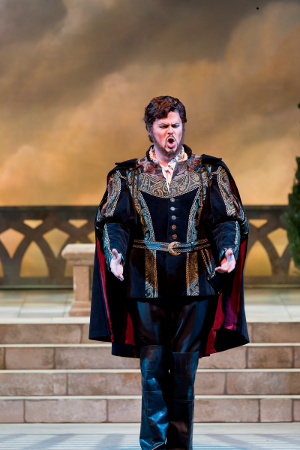 Sean Anderson as Iago
Sean Anderson as Iago
Rafael Davila’s performance of Otello comes with a few asterisks. Davila is, as far as this writer is concerned, on a very short list of tenors that are capable of sporting the naval jacket of Pinkerton and donning the “Lion of Venice” robe of Otello within five month’s time, performing both satisfyingly. More remarkable is this, on opening night March 3, was the Puerto Rican tenor’s first assumption of the role. It will be a treat to hear Davila’s Otello in other theaters. Davila will make first appearances with Washington National Opera as Pollione and in Bilboa as Ismaele (Nabucco) later this year. Otello is a real marathon, so when Davila came out and made a statement for “Esultate” — the singing was secure, had good weight and there was careful communication with the pit for the tricky note patterns — the memory of others that did not make it past the second act came to mind. Davila’s singing was caressing, with lines shaped in untraditional ways for the duet. In Act II, Davila delved into Otello’s insecurities while his voice continued to expand in expressiveness, pinging out B naturals and riding the passagio with clear tone. Davila simply patted some of Otello’s lower passages.
It is one thing to bluster through with power as some Otellos are like to do, another to pierce through the orchestra and sing mellifluously as Davila did. In “Dio mi potevi scagliar,” Davila expressed heartbreak and defiance; “Nium mi tema” was every bit a last gasp of love. Otello’s asides to Desdemona in act three were carried out excellently — Davila changed both tension and volume of voice without a hitch. This performance was missing, waiting for it, a tugging hostile polarity between Otello and Iago.
Some would argue that finding, or making, an Iago is a greater problem in casting this opera. In the early stages of its development, Otello’s librettist Arrigo Boito and Verdi only half-jokingly considered naming it after the vile ensign. Much of the challenge in the role of Otello lies in matters vocal; Iago has some difficult music to be sure, but it is in the psycho-drama, in Iago’s sowing seeds of malice, in his mutually disgusting and seducing, that this opera turns into a mesmerizing show. Verdi believed that in Iago, Shakespeare “invented the truth.” The most accomplished of baritones have fallen short of finding the truth in Iago.
Davila and Sean Anderson (Iago) have worked together before. Anderson is another Sarasota Opera perennial — he was a terrific John Proctor in The Crucible here last season. If Anderson gets any other opportunities to go deeper into Iago, he might could connect the text and method in the profound way he did with Proctor. Anderson’s singing was steady, with some highlights — the drinking song was like a warm-up (with little fun and a few ratty downward scales). Iago’s satisfaction over bringing down the Moor was well-announced but when Anderson gingerly floated his boot over Davila, setting it down gently, Iago became awkwardly maudlin over menace.
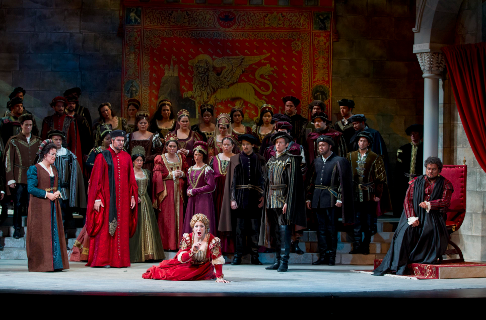 Maria D’Amato as Desdemona
Maria D’Amato as Desdemona
The Sarasota Opera chorus, with Roger L. Bingamen chorus master, takes any show here to another level. In Otello, the chorus came in strongly — both musically and in acting — just after Otello’s entrance. Then, they were on — shadings and dynamics for the storm were of great attention to detail, as was the fanfare of act three.
The role of Desdemona is in some ways remote, with motivations and inclinations in an alternate universe compared to those of the defending Italians and maraudering (though hapless) Turks. Desdemona has to communicate this distance, and the heart break and twisting frustration she suffers from not understanding the world Shakespeare has put her in. Maria D’Amato, in long glossy blonde curls, sang beautifully, displaying desperate desire for closeness to Otello early on, and for mercy and understanding up to her death bed. Her “Willow song” and “Ave Maria” were all those things that must be — prayerful and giving, and with the will to ask for what one wants.
As Cassio, Heath Huberg (who reappears and puts on lovely French for Remendado in Carmen this season) did a fine job, unsuspectingly playing into Iago’s hands in a role that’s launched the principal part career of many a tenor. Mathew Edwardsen’s Roderigo was effective as Iago’s clumsy tool — his fight (choreographed by Brian Robertson and staged by Stephanie Sundine) with Huberg was lively plus. It felt as though Cynthia Hanna, a Studio Artist with the company, was often separated from the goings-on as Emilia. Other Studio Artists took the roles of the Herald (Dinitre Lazich), Lodovico (Jeffrey Beruan), and Montano (Stephen Fish).
The orchestra sounded in much better shape accompanying singers in arias than in instrumental sections or playing for the chorus. The storm scene was an exception: the ebbs and flows and stridency of a tempest were captured by finely coordinated string and horn sections. The rather fast tempo set by Maestro DeRenzi rarely varied but he rarely missed an opportunity to spin a line movingly, or powerfully, along with singers — the “Un bacio” line (the “Kiss” motif) had more depth each time played, the “Credo” was finely timed, “Dio mi potevi scagliar” was shaped with deference for Davila’s stage position and actions, and in the “Canzone del Salice” the orchestra mourned as if pitying Desdemona.
“Others have ceded their places to us and we must cede ours to still others. I am more than happy to give mine to people of talent like Verdi,” Gaetano Donizetti wrote. As we know, Verdi ran with that baton — putting Otello to opera much later. It was a time that bore similarities to today; the public was crazed over what it wanted. Today that means new applications, and successively smart and smarter electronic devices. Back in the mid-19th century, the public frothed at the mouth for more opera. At this Verdi was ready and willing to oblige; Donizetti fared less well and history will say that he buckled under the pressure of producing opera to meet the perceived demand. He ended up institutionalized, a similar consequence that befalls Donizetti’s best known operatic creation: Lucia.
Lucia di Lammermoor represents a plot on the operatic timeline, of which Otello is beneficiary and derivative. Lucia and Otello then are linked beyond the two running together in repertory as is the case this season in Sarasota.
The opening scene of Lucia — bearing a few similarities to Otello’s opening story — all the way through the first scene of act two was tepid in this performance (on March 2). That changed in scene two — the chorus sprang to life with full sound and more movement. Brain Robertson (visiting stage director) was in on lifting the action: the chorus knelt as Raimondo finished telling of the horror he just witnessed. It was surreal but effective.
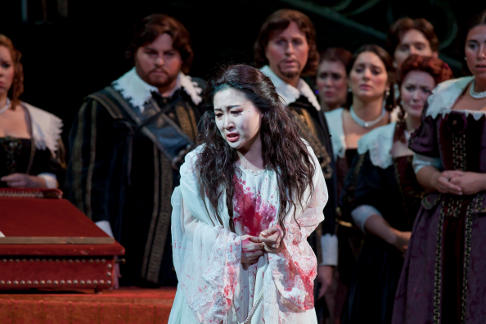 Kathleen Kim as Lucia
Kathleen Kim as Lucia
As far as keeping interest stimulated, the flute took up that responsibility. Marie Tachouet (principal flutist) and Kathleen Kim, the Lucia, paired note-for-note through familiar music and unconventional ornamentation. "I worked with my teacher on cadenzas first. I didn't want to limit myself to the ‘traditional way.’ So, we tried to find and create cadenzas that suit my voice; fresh and effective in the boundary of the style. When I met Maestro Barrese, of course, he had a few ideas. So we shared what we each had and came up with to create what has become final product." Visiting conductor Anthony Barrese’s ideas here are grounded in flexibility: “it [the cadenza] should have definite points of improvisation (in the beginning section whatever Kathleen sings the flute mimics, and this process is reversed at the end. Both the singer and flautist have been encouraged to change this up from night to night.)” “as the flute gains ascendancy, it simultaneously reflects the dramatic idea that "madness" has taken over, while providing Kathleen time enough to recoup for her final high note."
In Sir Walter Scott’s novel, Lucy is 17 years old and it is on that account that Ms. Kim so well characterizes Lucia. A Metropolitan Opera regular of late, the “tiny dynamo” — as Kim has been referred to — lent an adolescent quality to her parlando as the Scottish girl caught in a desperate situation. Kim’s light sound, constrained on high this evening, has no problem being heard.
Joshua Kohl (Edgardo) produced an inconsistent sound. Enough was heard though to describe it as quite attractive when produced cleanly. Kohl seemed to thrive with others on stage, doing well across the board up to the and after the Tomb scene which was shaky; he fumbled through “Fra poco a me ricovero.” When others entered the cemetery, Kohl’s singing was again quite lovely — his cries at “nume in ciel” were sung beautifully. Lee Poulis, Sarasota’s Giovanni last year, put his pointed baritone to work as Lord Enrico Ashton. Sarasota perennial Young-Bok Kim’s Raimondo was workmanlike, as were the Arturo of James Chamberlain (whose makeup shiny and campy), the Alisa of Daryl Freedman, and the Normanno of Steven Uliana, the latter three Studio Artists with the company.
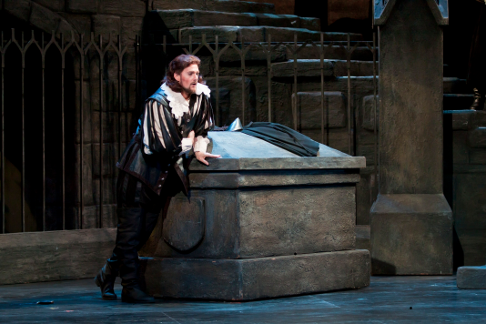 Joshua Kohl as Edgardo
Joshua Kohl as Edgardo
Lucia’s last act is noteworthy as far as set designs (Robert O’Hearn) go this season in Sarasota. The island-style tomb, upstage-right, and the cloudy ambiance were of fine visual quality, with care for audience sightlines and depth in features (carvings and shadows).
As Donizetti did in making way for Verdi, Verdi made way for others. Even if he seemed to object to “symphonic” biases creeping into opera composition, Verdi understood such things were inevitable. Georges Bizet was probably in that group of composers Verdi thought were refashioning the making of operatic music. But, Verdi’s Otello and Bizet’s Carmen are alike in significant ways.
On the operatic timeline, the operas are separated by a mere 12 years. They are both leitmotif driven; where Otello has the “Kiss” theme, Carmen has the “Fate” theme. One big difference has to do with the developments at the time of recitative in opera, spoken parts and different operatic cultures, as found in Carmen. In this dynamic is where this performance (a matinee on March 4th) of Carmen was distinguished.
DeRenzi chose to go with the original spoken dialogue the Opera Comique audience heard at Carmen’s first showing in 1875. This can give Carmen another life: the “mental massage” is in full force and tells a little of Bizet’s talent for comedy. An emphasis on language favors artists who have an affinity for it, and this cast had a few ringers. The level of French never strayed lower than good and there were a few examples of Francais delicieuse, some of the most delicious produced by bass-baritone Stephen Fish as Zuniga.
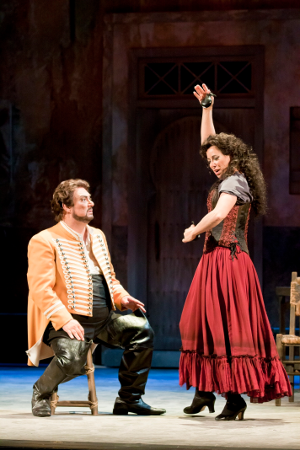 Antonio Nagore as Don Jose and Fredrika Brillembourg as Carmen
Antonio Nagore as Don Jose and Fredrika Brillembourg as Carmen
Fredericka Brillembourg’s French was sassy and spirited, her Carmen cold and fun. In the mountainous outskirts of Seville, gypsy women would have clawed each other’s eyes out for the right to a man. After, they would be like sisters, commiserating and using their wiles to survive — this came through in the connection between Brillembourg and Studio Artists Sarah Asmar (Frasquita) and Vira Slywotzky (Mercedes). Their hugging, stealing whispers, and ease in sharing space with each other — due to the work of Martha Collins (stage director) and Carolina Esparza (choreographer) — also distinguished.
The Don Jose of Antonio Nagore, a native Arizonian, was very much a characterization driven by voice, a good job of casting. Nagore’s spinto was beefy and proved durable. The Escamillo of Carlos Monzon was a case of characterization by looks. The Mexican bass-baritone was all hot-blooded Hispanic, with oily slicked-back bun and dark olive skin. Danielle Walker made some beautiful music in “Micaela’s song” and was not completely absent from the story as can happen with this role.
The rest of the events onstage contributed to the comedy — other soldiers played inept, other gypsies scheming, the gypsy smugglers, also inept. The group of kids assembled by Youth Opera chorus master Jesse Martins had a raucous good time making good music and fun.
DeRenzi’s treatment of Carmen was more “big-picture” than in Otello and paced just as evenly. The orchestra, wavering as woodwind playing was right at the start, took Carmen as a whole. In Carmen this meant playing to the different parts without too much emphasis on showpieces; there were light strings and muted horns for the fate motif and Carmen’s solos were as much for the orchestra, and even more so for the words, to shine. The “Flower song” was another example of this — the volume and intensity was restrained in returning to the tonic (fate motif) and at the peak of the vocal line. The one moment where the orchestra notably let loose was at the entr’acte of act three.
David P. Gordon’s first act (the square in Seville) was an example of a fine job making the most — using small staircases and wells, and tiered walkways — out of closed quarters.
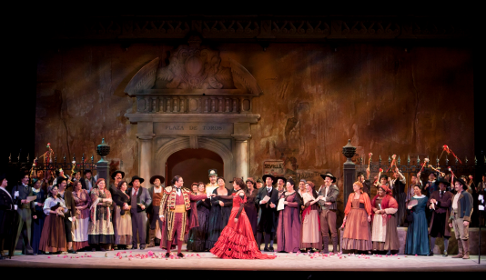 Scene from Act IV of Carmen
Scene from Act IV of Carmen
Sarasota Opera’s interest in continuing to rouse audience expectation led to the American Classic Series begun in 2011. The project goal is to present the operas of American composers. This season, Samuel Barber’s Vanessa ran from March 10th through the 24th.
As far as expectations go, visitors to Sarasota in March can bet on more than just opera, and Verdi, to welcome them; expect sunny days, soothing breezes off the gulf, and powder soft sand on fantastic beaches. In so far as there existed a timeline plotting the production of high quality opera, Sarasota Opera will stand apart as an example of what opera could be in the early part of the 21st century.
Robert Carreras
image=http://www.operatoday.com/Sarasota_2012_Otello01.png image_description=Rafael Davila as Otello [Photo by Rod Millington courtesy of Sarasota Opera] product=yes product_title=Sarasota Opera 2012 Winter Festival product_by=Click here for cast and production details. product_id=Above: Rafael Davila as OtelloPhotos by Rod Millington courtesy of Sarasota Opera
April 12, 2012
International HD Broadcast of Rigoletto by Royal Opera House
This Rigoletto is the well-known David McVicar production from 2001, but this time the conductor is John Eliot Gardiner. He’s one of the great specialists in baroque and early music. This was not his first Verdi opera, but his first Rigoletto, so he was an inspired choice as conductor. Yet those who know period instrument practice know how rambunctious it can be. Gardiner’s Rigoletto is vigorous, capturing the turbulence of the Renaissance.
Be shocked by the licentiousness you see in the First Act. But McVicar’s not out to titillate, but to make us feel revulsion. For the Duke of Mantua, sex is a weapon, like any other abuse of power. We’re not supposed to approve. Listen to how Gardiner’s tight, disciplined approach challenges the depravity of this Court. At the first performance in this run (review here), Gardiner showed how Verdi builds moral purpose into the orchestra. Gardiner’s strong sense of structure, which undercuts any attempt at sentimentality. Listen out for small details, such as when flutes cut through the broad swath of strings. Small, individual voices that stand up to the mass. Gilda is powerless, but proves to be the most heroic person of all. Verdi tells us this even before she makes her sacrifice. Gardiner’s period background also shows in the way horns, trombones and cimbasso can be used to create 16th century colour even if the instruments are modern. This is a Rigoletto to listen to, as pure music.
Vittorio Grigolo sings the Duke of Mantua. He, too, is a good reason for catching this broadcast, as the emphasis on the Duke, rather than on Rigoletto brings out deeper perspectives on the role and on the opera. Grigolo and Gardiner contrast extremely well, one taunting the other, as should be, in this highly principled interpretation.
Grigolo makes an impact the moment he enters. “Questa o quella” is thrown like a gauntlet. Grigolo has the showmanship to create the Duke, strutting with arrogant machismo. The Duke luxuriates in his flashy image, and Grigolo glories in the flamboyance of his singing. This is no defect, but an accurate reading of the role. Grigolo’s Duke swaggers, for it’s his way of keeping control, of the courtiers and perhaps, of himself. There’s no room for subtlety. Thus, when the Duke falls for Gilda, it’s even more poignant when he almost reveals his inner fragility.
It’s then when Grigolo shows the depth of his characterization. With Gilda, he can play the man he might have been had he not been born to a crown. The duet with Gilda is genuinely tender. In “Ella mi fu rapita”, Grigolo lets the Duke’s mask drop for a moment, singing with genuine tenderness. In many ways this is the heart of the opera for it touches on the Duke’s inner psyche. Yet it’s not something the Duke can be comfortable with. Significantly, Verdi keeps cutting “La donna è mobile” so the sections don’t connect. Gardiner emphasizes the disjoint, for by this stage, the Duke is back to his old tricks, morally disintegrating once more. Grigolo’s voice gradually fades, for now the Duke is running away, blaming everyone but himself. Grigolo is a consummate actor and creates the part better than he’ll get credit for. The problem is that the Duke himself isn’t sympathetic and is a difficult character to portray.
Ekaterina Siurina sings Gilda with great personality, and Dimirtri Platanias sings Rigoletto. American audiences may recognize Matthew Rose, who sings Sparafucile, and ihas appeared at the Met, Santa Fe, Los Angeles, Houston and at the Mostly Mozart series in New York. He’s very unusual in that he’s a British singer whose career took off in the United States. This gives him a unique perspective.
Discovered by the British baritone Benjamin Luxon, Rose won a place at the Curtis Istitute and received his early training in Philadelphia. Because the opera faculty at Curtis is compact, unlike London, a singer gets more intensive experience at a fairly early stage. “It was wonderful”, says Rose, because he was able to sing good roles with well established singers. “It was like being on a top football team. When you’re working with stars, it raises your own game”.
Rose speaks of Curtis fondly, but decided to return to Britain where he started again as a Young Artist at the Royal Opera House. Moving back to Europe expanded his repertoire. He made his Royal Opera House debut in 2003 and is also a regular at Glyndebourne. He’s enterprising, too, and runs a music festival in Sussex and plans a Britten series in Berlin next year. He’s worked with the Britten-Pears Foundation. He’s also very experienced in oratorio, and has worked with John Eliot Gardiner many times.
Watch how Rose sings Sparafucile. He’s imposing. While the Duke of Mantua is immoral, Sparafucile is amoral. Rose doesn’t need to invest the part with histrionics. To Sparafucile, murder is a business transaction without emotional meaning. Rose’s detachment is chilling in itself. In his exchanges with Christine Rice’s Maddalena, Rose’s sibilants cut with suppressed sexual violence. They’re not “brother and sister” in the modern sense of the term, but pimp and whore. Rose makes you wonder how Sparafucile came to be who he is. He’s brutal, but is it personality or circumstance?
More people will experience opera on film than will ever attend live performances, so film is an essential part of the business. Filming opera is an art in itself. Whoever directs a film of an opera needs to understand the opera, and also how the cast, production and music express its meaning. Film is the next frontier. Kaspar Holten, the new Director of Opera at the Royal Opera House, is a movie buff as well as an opera professional, and directed his Juan (see the review in Opera Today here). But that was a film for it’s own sake, not a film of the opera as such. By far the majority of filmed operas will be attempts to capture live performance as it happens in the theatre. Good opera filming is a skill that requires musical knowledge as well as film technique, and above all, sensitive response to relevant detail. Fortunately, the Royal Opera House has the resources and commitment to do it well. For more information, please see this link to the Royal Opera House cinema page.
Anne Ozorio
image=http://www.operatoday.com/Rigoletto_ROH_2012_05.gif image_description=Dimitri Platanias as Rigoletto [Photo © ROH 2012 / Johan Persson] product=yes product_title=Giuseppe Verdi: Rigoletto product_by=Rigoletto: Dimitri Platanias; Gilda: Ekaterina Siurina; Duke of Mantua: Vittorio Grigolo; Matteo Borsa: Pablo Bemsch; Count Ceprano: Jihoon Kim; Countess Ceprano: Susana Gaspar; Marullo: ZhengZhong Zhou; Count Monterone: Gianfranco Montresor; Giovanna: Elizabeth Sikora; Page: Andrea Hazell; Court Usher: Nigel Cliffe; Maddalena: Christine Rice. Royal Opera Chorus. Orchestra of the Royal Opera House. Conductor John Eliot Gardiner. Stage Director David McVicar. Royal Opera House, London. product_id=Above: Dimitri Platanias as Rigoletto [Photo © ROH 2012 / Johan Persson]April 2, 2012
Rigoletto, Royal Opera House
There’s a lot to be learned from period practice, and anyone who knows it well knows how rambunctious it can be. Gardiner knows the Renaissance was violent. Verdi isn’t sentimental and the court at Mantua was cruel. This was historically-informed practice adapted to repertoire often milked for lush effect. Gardiner’s vigorous approach might not appeal to all, but it’s extremely perceptive. He makes Rigoletto raw and shocking, as it should be.
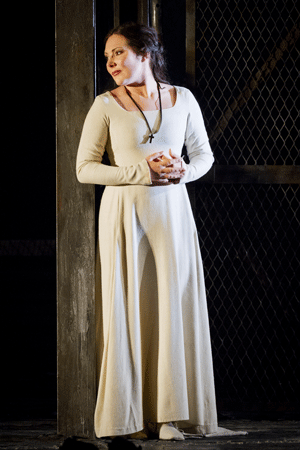 Ekaterina Siurina as Gilda
Ekaterina Siurina as Gilda
David McVicar’s 2001 production is bleak. The ducal palace is evoked by a metallic wall — shiny but hard. Michael Vale, the designer, uses a large wooden structure that pivots like the twists in the plot, but the focus remains on the cast. Vocal performances take their cue from Gardiner and McVicar. Vittorio Grigolo bursts onto the stage in full throttle. “Questa o quella” is thrown like a gauntlet. The Duke doesn’t brook challenge. Grigolo has the power and showmanship to create the Duke, bursting with arrogant machismo. Like the Duke, he’s a force unto himself. The courtiers are a mob for whom subtlety means nothing. Grigolo’s Duke uses swagger as a weapon. The Duke’s brutishness come over well, moments of decorative richness adding a touch of devious artifice, totally in keeping with character.
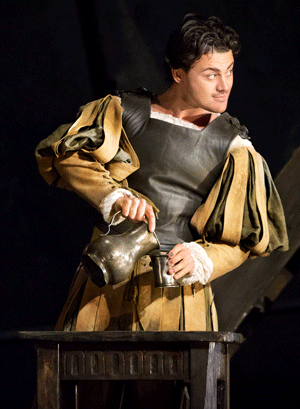 Vittorio Grigolo as Duke of Mantua
Vittorio Grigolo as Duke of Mantua
Yet Grigolo also manages to suggest the Duke’s inner fragility. With Gilda, he can play the man he might have been had he not been born to a crown. The duet with Gilda is genuinely tender. In “Ella mi fu rapita”, Grigolo let the Duke’s mask drop for a moment, singing with genuine tenderness. In many ways this is the heart of the opera for it touches on the Duke’s inner psyche. Significantly, Verdi keeps cutting “La donna è mobile” so the sections don’t connect. Gardiner emphasizes the disjoint, for by this stage, the Duke is back to his old tricks, morally disintegrating again. Grigolo is a consummate actor and creates the part with more depth than he’ll get credit for. The problem is that the Duke himself is hard to pin down.
There have been so many great Rigolettos over the years that Dimitri Platanias has a lot to live up to. This was his Covent Garden debut, though he has done the role many times elsewhere. McVicar’s concept has Rigoletto crawling like a broken spider, which is perfectly valid. Platanias is physically imposing, with a voice to match, so a different concept would perhaps suit him better. Platanias does Rigoletto’s anger rather than his anguish. His dialogues with Gilda show Rigoletto’s fatherly side, but don’t access the demented, tortured soul within. Nonetheless, he’s a good counterbalance to Grigolo’s Duke and to Matthew Rose’s Sparafucile, sung with the power of an amoral force of nature. Rose doesn’t need to invest the part with histrionics. To Sparafucile, murder is a business transaction without emotional meaning. Rose’s detachment is chilling in itself. In his exchanges with Christine Rice’s Maddalena, Rose’s sibilants cut with suppressed sexual violence. They’re not “brother and sister” in the modern sense of the term, but pimp and whore.
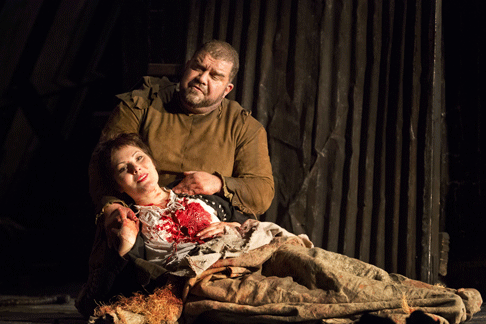 Dimitri Platanias as Rigoletto and Ekaterina Siurina as Gilda
Dimitri Platanias as Rigoletto and Ekaterina Siurina as Gilda
Ekaterina Siurina is an impeccable Gilda. It’s her signature role with which she debuted with Dmitri Hvorostovsky at the age of nineteen. A beautifully rounded, sensual “Caro nome” expresses the passion in Gilda’s personality, making her love for the Duke perfectly plausible. Gilda is too sheltered to articulate her feelings, but her instincts burst forth. Siurina’s clear, ringing timbre and perfect pitch make the long cadenzas bloom with promise, expressing emotions that words can’t convey. This intensity makes her sacrifice believable too. When Siurina appears dressed as a boy, her voice glows with purpose, for she’s found a way to fulfill her love in a sacrifice only a cloistered Catholic innocent might chose. Ironically, Rigoletto loses his child because she’s been brainwashed by her upbringing.
This was an extremely rewarding Rigoletto because it cuts past surface glamour and goes to the visceral drama.
The performance on 17th April will be broadcast live internationally in HD cinemas.
Anne Ozorio
image=http://www.operatoday.com/Rigoletto_ROH_2012_05.gif image_description=Dimitri Platanias as Rigoletto [Photo © ROH 2012 / Johan Persson] product=yes product_title=Giuseppe Verdi: Rigoletto product_by=Duke of Mantua: Vittorio Grigolo; Matteo Borsa: Pablo Nemsch; Count Ceprano: Jihoon Kim; Countess Ceprano: Susana Gaspar; Rigoletto: Dimitri Platanias; Marullo: Zhengzhong Zhou; Count Monterone: Gianfranco Montresor; Sparaficule: Matthew Rose; Gilda n: Ekaterina Siurina; Giovanna: Elizabeth Sikora; Page: Andrea Hazell; Usher: Nigel Cliffe; Maddalena: Christine Rice. Royal Opera Chorus. Orchestra of the Royal Opera House. Conductor John Eliot Gardiner. Stage Director David McVicar. Royal Opera House, London, 30th March 2012. product_id=Above: Dimitri Platanias as RigolettoPhotos © ROH 2012 / Johan Persson
Met Opera on Demand
By Frank Cadenhead [2 April 2012]
The Metropolitan Opera now has a free App for iPads available on their site allowing easy access their range of operas available on HD video. An extension of their earlier Video on Demand system, it also provides access to some 250 audio recordings of operas from their library. They will have available the operas broadcast live during the current season but a few months after their appearance at the cinema. Costs range from $3.99 for a single opera to $149.00 for an entire year. Operas on video include historic like La Bohème with Pavarotti and Renata Scotto and a Rigoletto with Domingo and Contrubas from 1977. The audio recordings start with a 1936 Götterdämmerung with Lauritz Melchoir and Marjorie Lawrence.
